Some posts on this site contain affiliate links. If you book or buy something through these links, I earn a small commission (at no extra cost to you). Take a look at my privacy policy for more information.
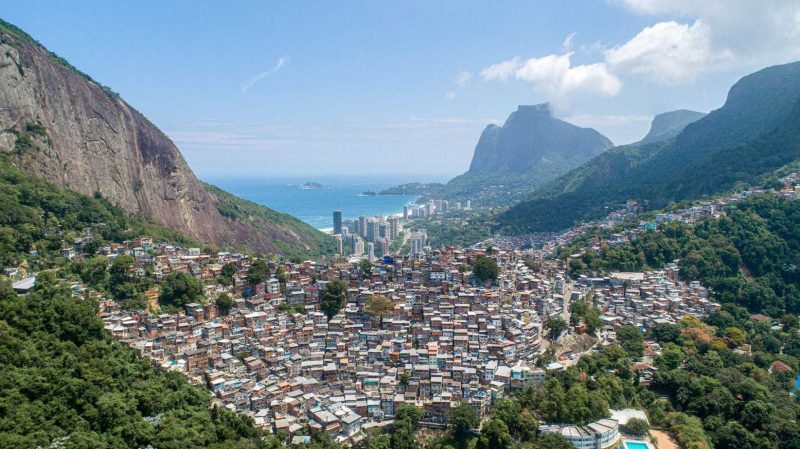
Back in 2014, I spent five months backpacking through South America with my then-boyfriend. Argentina was the sixth and final country on our itinerary, after starting in Colombia and travelling overland through Peru, Bolivia, Chile, and Argentina.
We crossed into Brazil from Argentina at Iguassu Falls – making sure to visit the iconic South American waterfalls on both sides – before continuing on to Belo Horizonte, Porto Seguro, Paraty, and finally Rio de Janeiro. Our trip to the capital coincided with the 2014 World Cup final, so it was an extra-exciting time to be there.
Throughout our whole trip, I published blog posts in (almost) real-time. Those posts are now a decade old, so are probably too out of date to be of any use to other travellers. They’re also a little embarrassing! I like to think I’ve improved a lot as a writer in the last decade – and these posts are more like nerdy diary-style blog entries.
Realistically, they don’t have a place on my site any more. But that South America trip was a huge chapter in my life – and a turning point in my career as a blogger. These blog posts are part of the journey that brought me to where I am today. So instead of deleting them all, I’ve gathered them all up, in order, onto one page.
Honestly – I’m only keeping these blog posts here for me, because they have so much sentimental value! I’m only writing this intro in case anyone stumbles upon this page and wonders what’s going on!
So – here are my Brazil diaries in all their original, innocent glory…
Iguassu Falls – aka Foz do Iguaçu, Brazil
20th June 2014
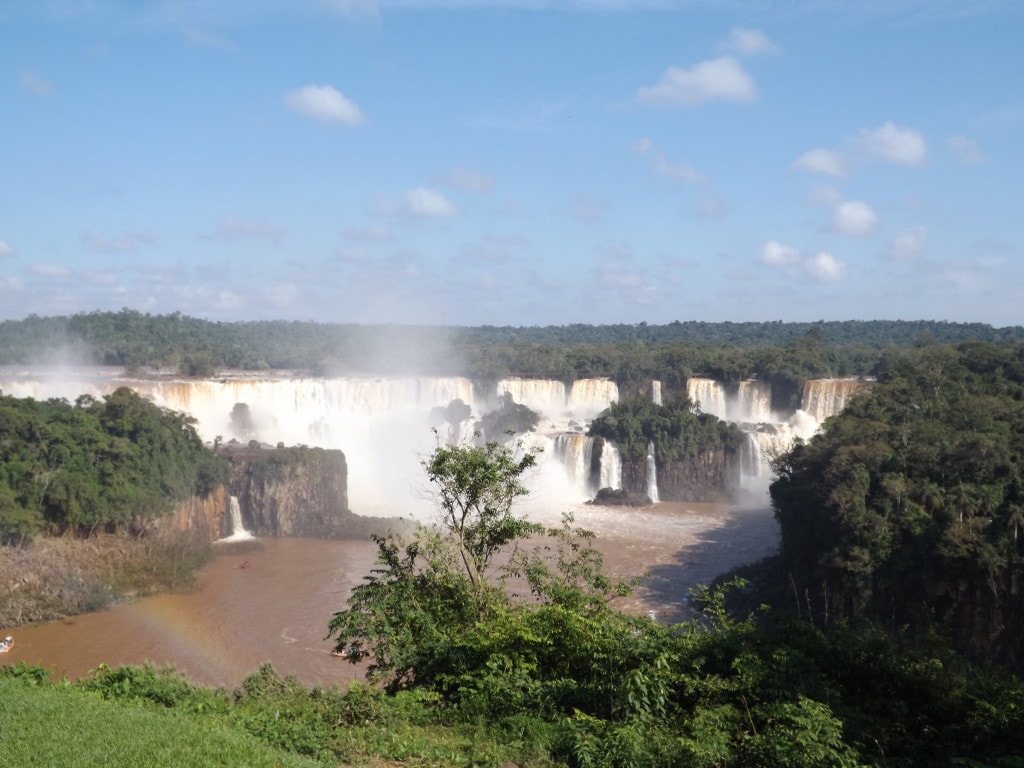
It sounds foolish to say it now, but as soon as we crossed the grey concrete bridge from Argentina to Brazil I noticed a difference that seemed to lie in more than the new language showing on every sign and shop front. Foz do Iguaçu, just a short drive down the road from Puerto Iguazu in Argentina, really felt like a different country – strange for a place separated only by a river and a tiny border control.
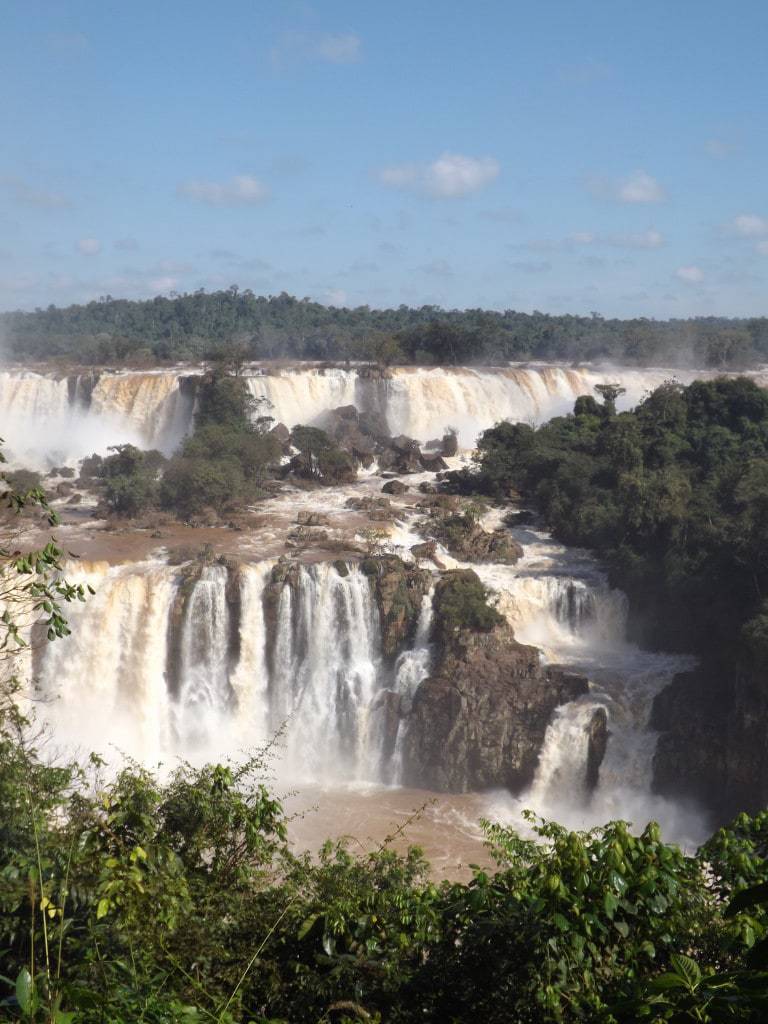
The difference was even noticeable on the Brazil side of the actual falls themselves. Although the river, forest and waterfalls themselves were of course no different, the views and the National Park felt a world away from the Argentinian side, proving that the only way to truly experience Iguassu is from both sides.
For starters, the park itself was a little more modern and sleeker, with a big, fancy complex of ticket offices and shops at the entry, and a transport system included in the ticket price to take us from the entrance all the way to the start of the waterfall trail.
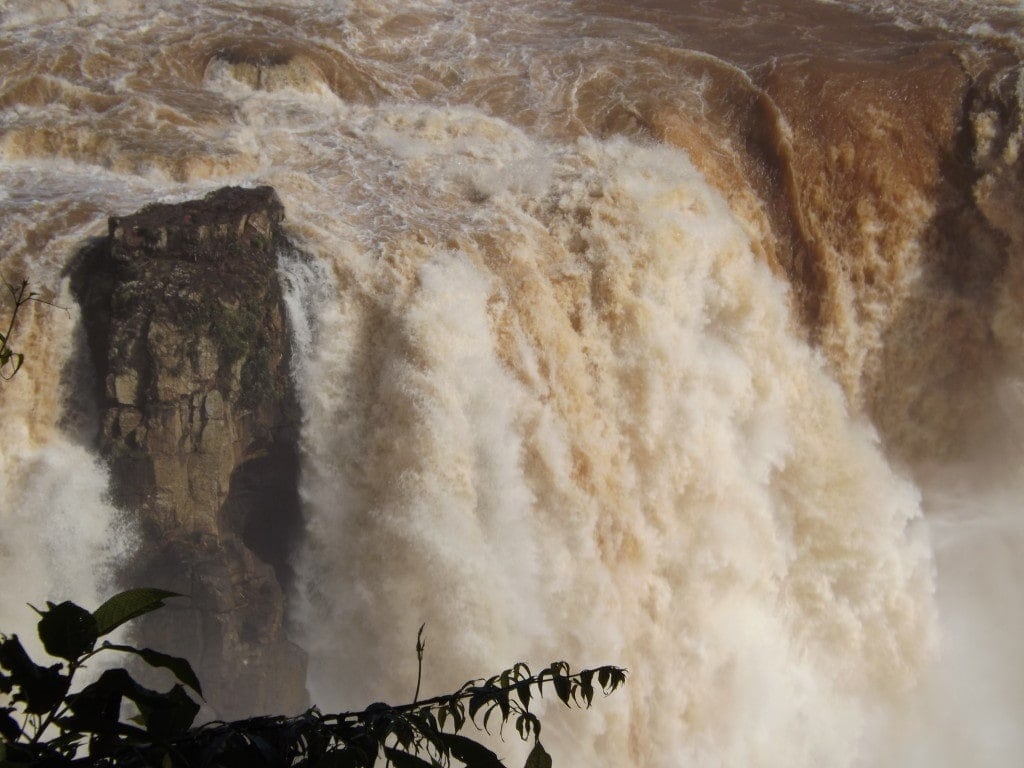
While Argentina have multiple trails offering various views of the falls, as well as ferry tours to the central island (unfortunately closed due to flooding when we were there), Brazil only have the one trail. This starts pretty far back, affording incredible views across the falls and over to Argentina. We arrived later in the morning on our Brazil-side visit to the falls, which meant that all the mist had cleared up leaving bright blue skies and brilliant sunshine. As we followed the trail, the view just seemed to get better and better, and once we’d rounded the edge of the cliff a little, to where the air was heavy with rain from the spray of the distant falls, which caught in the leaves of the forest and fell down on us, we were hit by the most impressive sight yet; the view of the horseshoe section of the falls known as Garganta do Diabo (Devil’s throat). We’d wanted to view this from up above the day before, but again due to the flooding this trail had been shut on Argentina side, so this was our first view of the Garganta, and it really was breath-taking. The spray from the thunderous ring of falls was so thick that we couldn’t even see the back of the horseshoe, and the falls we could see were so fast and powerful that they didn’t even seem like water; more a heavy blur of white.
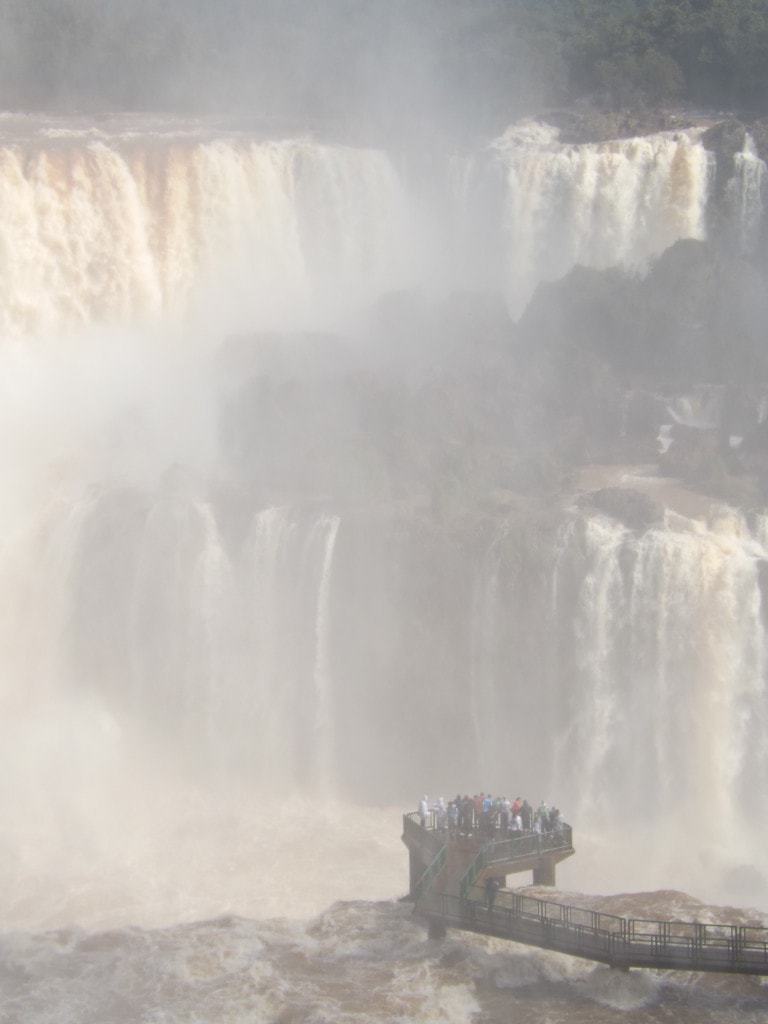
The trail on the Brazil side creeps in one more or less straight line right along the edge of the river and as close to the falls as they can get. After zigzagging down the cliffside to the level of the lower river, an optional side trail led us out into the very centre of the Garganta do Diabo . I don’t recommend heading out along this pier-like pathway unless you’re wearing a decent raincoat and very fast-drying shoes and trousers – and definitely don’t take you’re camera or phone without protection. It was WET! The river below the path roared and splashed like a stormy sea, but it was the thick, white spray – a dense, misty fog hanging in the air – that had us completely soaked. The whole experience was great fun and very refreshing, but we waddled back onto dry land wet through with our dripping clothes adding to the growing puddle outside the queue for the observation lifts.
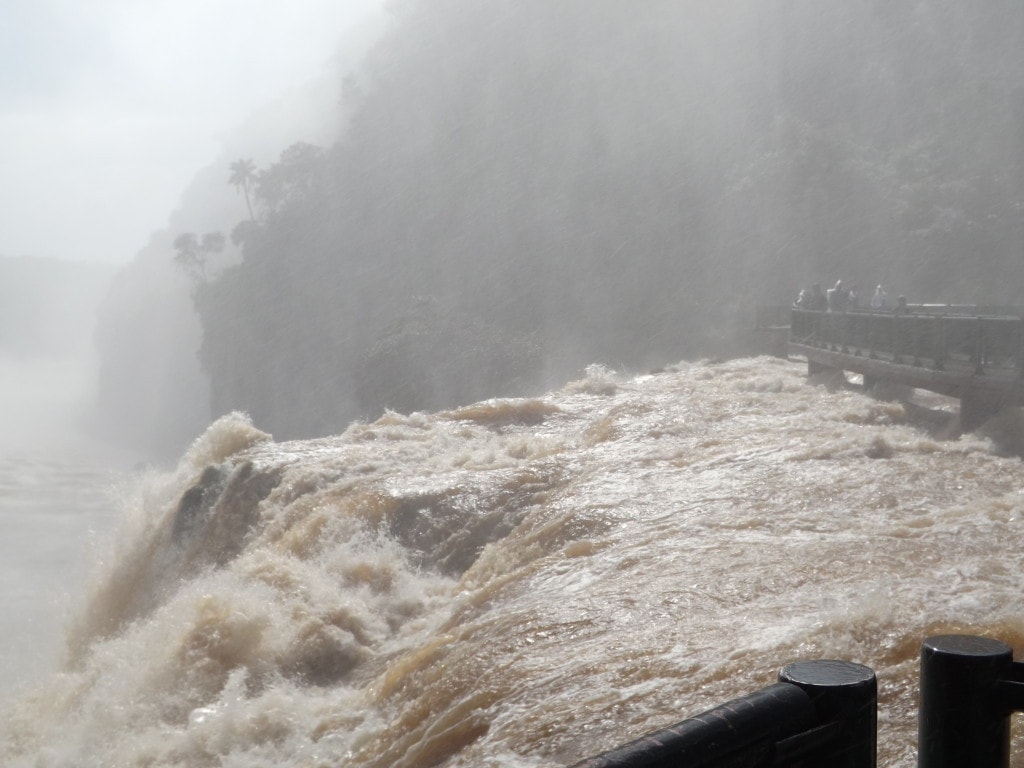
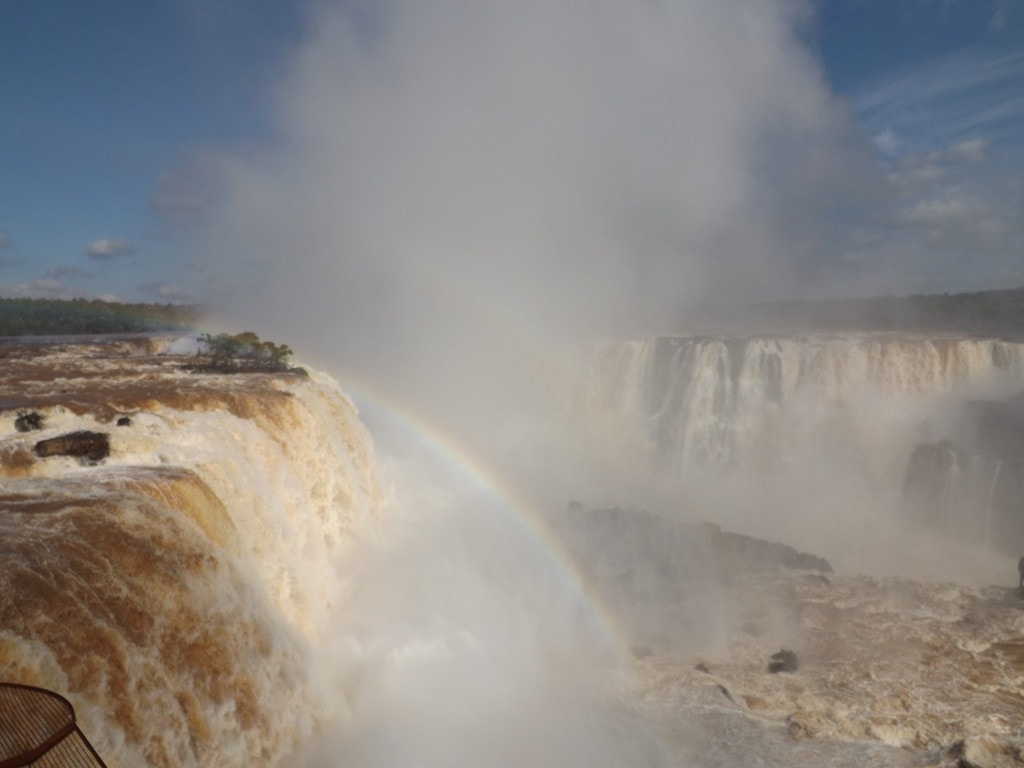
Glass-fronted lifts provided pretty good views of the horseshoe we’d just experience, but it was from the upper observation deck that we could really see the power of the surging water around the pier we’d just been stood on. The trail had led us neatly from distant, beautiful views to a thrilling up-close-and-personal experience of the powerful waterfalls.
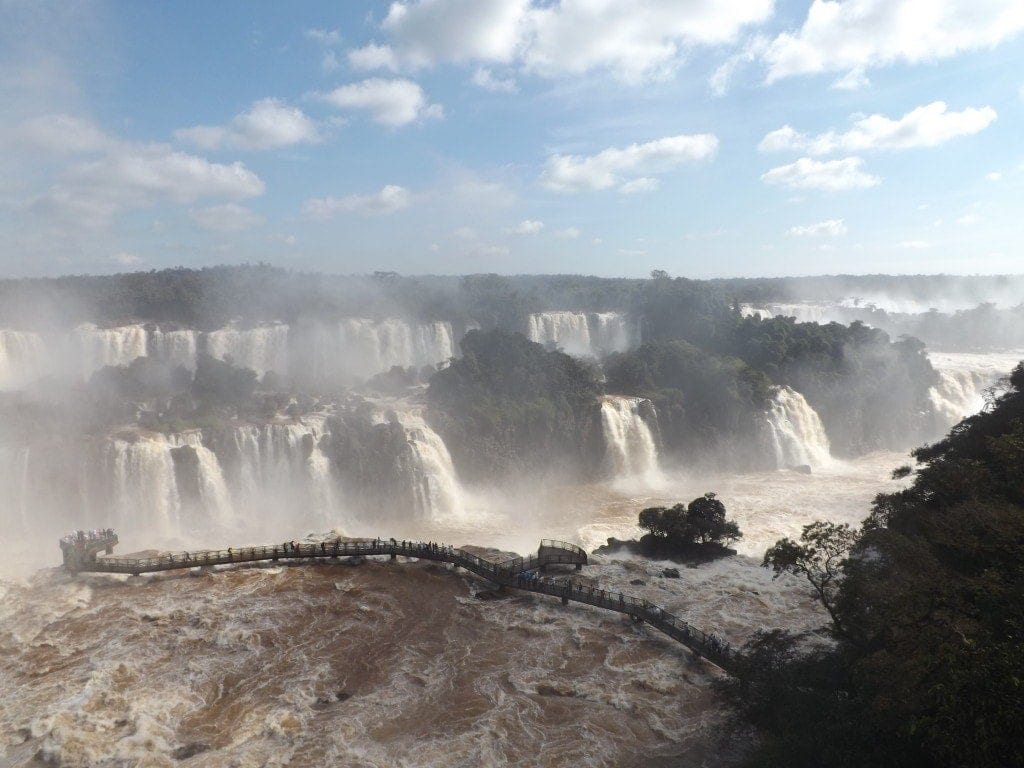
Trail done, we ate a picnic lunch alongside the river and then took the bus back through the park looking for additional trails through the forest. Unfortunately, these are all at an additional cost, so we opted out, and after watching the last fifteen minutes of the Italy vs Costa Rica game on a TV screen at one of the trail ticket offices (and finding out that England had definitely lost our group) we headed back to the main trail again for one last look at the falls. Revisiting the trail a second time is a great idea, because this time we put our cameras down – knowing that we’d already taken plenty of shots – and just experienced the incredible views. We’d done the same thing with the upper trail on the Argentina side the day before, and it’s a really nice way to make sure you really experience the falls without the distraction of a camera in front of your face!
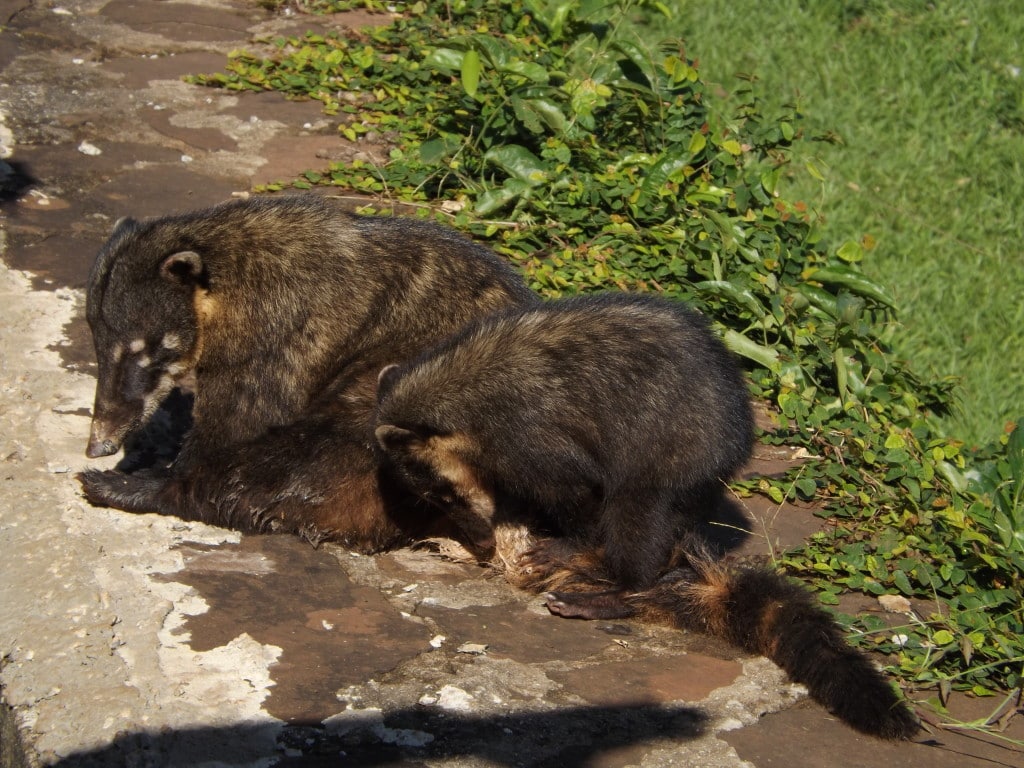
Since we were already dry after our wash in the Devil’s Throat, we didn’t walk all the way along the trail a second time, and only walked as far as where the spray “rain” started, then stood on one of the viewing platforms and just looked. I’m not exaggerating in any way when I say that the photos of Iguassu Falls simply do not do it justice; in fact I don’t really like any of the ones I did take because none of them capture the full experience; which involves the motion of the water, the power, the thunderous noise which can be heard from far away, the heat of the bright sun, the rich green forest, and the fragmented sunlight through brilliant, wet leaves, catching in rays on the misty air.
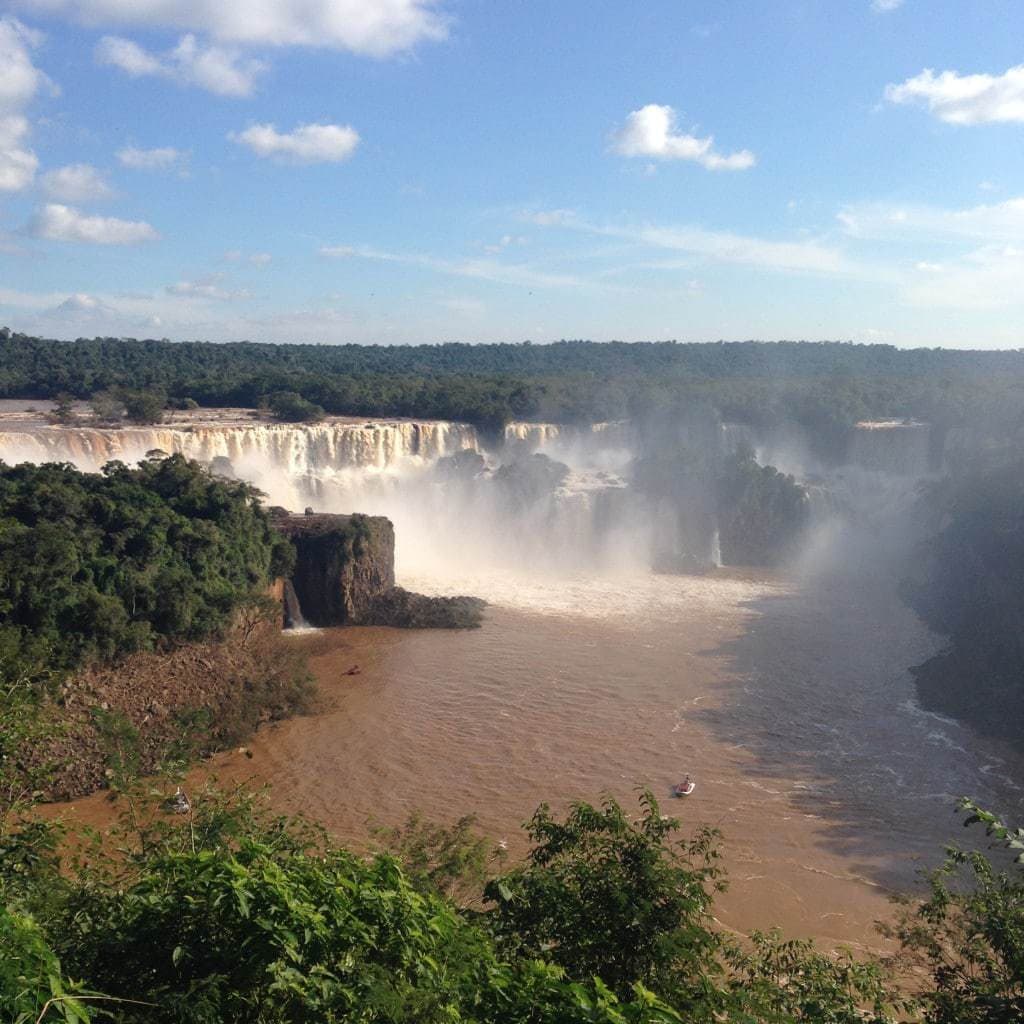
Without using too many clichés, I really did have to tear myself away from that stunning view when it was time to leave. We were both exhausted, the day was ending, and we had lots to sort out back at the hostel (like bus tickets to our next destination), but I could have stayed at the top of that trail for hours and just stared. I mentioned it in a previous post, why we should take fewer photographs, but I really did find myself disappointed when I saw people clicking their cameras a few times and then hurrying on to the next viewpoint of the trail. Iguassu, like all the wonderful places in this world, is about more than catching a couple of good photos. It’s a staggering sight of the incredible power of nature, a dizzyingly huge waterfall made up of over 150 individual falls, cutting across a wide, fast river. There are many visible traces of how the force of the river has shaped the landscape and created the falls, and hints of how these will change shape in the future, all proving just how strong and powerful nature can be.
Both sides of Iguassu are staggeringly impressive and have lots to offer even if you can only visit one half. But I’m so glad we got to experience the falls from both Brazil and Argentina – and I honestly can’t pick a favourite side.
Porto Seguro
25th June – 3rd July 2014
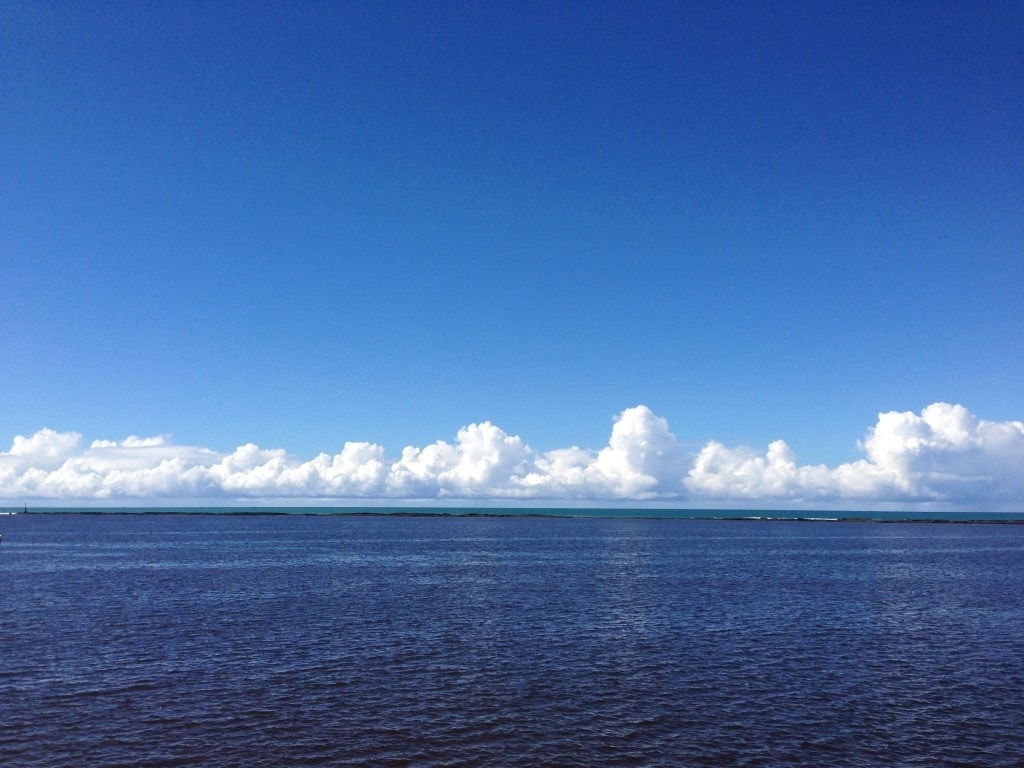
I’ve already mentioned that one side effect of the World Cup in Brazil this year was the stadiums driving visitors to towns which previously weren’t major tourist hotspots, like Belo Horizonte. Another effect was that the huge inflation of prices – particularly accommodation prices – in these cities drove backpackers like us out of the big towns and forced us to seek out smaller, less well-travelled destinations.
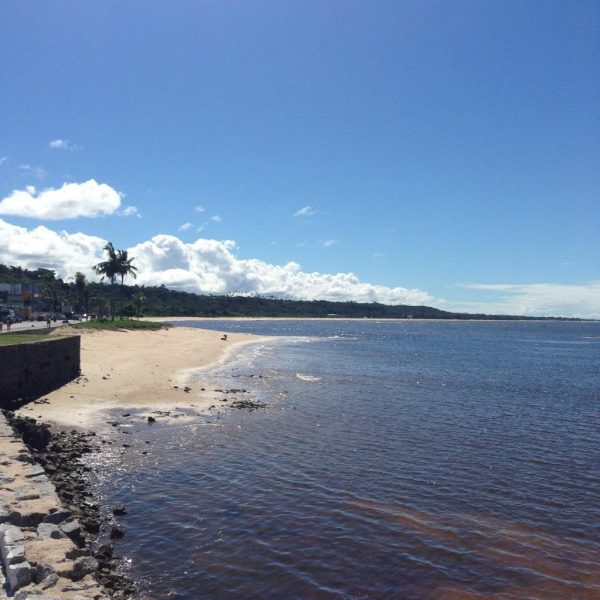
Where all our previous decisions about our route through South America had been based on previous knowledge or recommendations on the road, in Brazil our slightly misshapen route simply sought out the towns which had the lowest accommodation prices. The first such destination was Porto Seguro: far enough away from any World Cup towns to be affected, this popular tourist destination for inland Brazilians was experiencing a winter lull – meaning that we were able to stay in a private room at a reasonable hotel for less than £15 per night. It was chosen by a fluke; simply because out of the list of coastal destinations within bussing distance of Belo Horizonte it had the cheapest hotel rates I could find online.
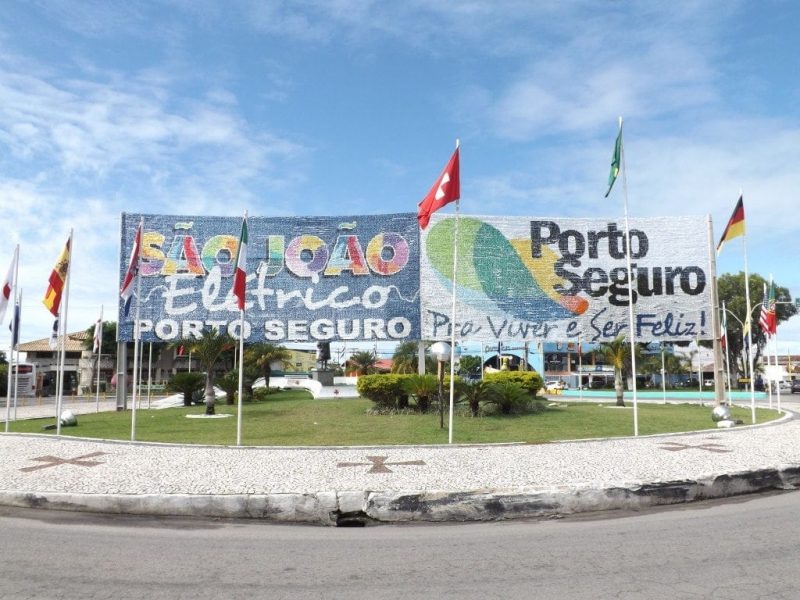
We arrived to a sleepy town which looks colourfully and pleasantly rundown, and which was celebrating the World Cup with a fervour that we didn’t see anywhere else in Brazil, even Rio. Aside from the world flags and huge banners welcoming visitors at the town’s entrance, the whole of Porto Seguro was completely covered in fluttering, coloured bunting which formed a ceiling over every street. Patterns, World Cup country flags, and words were depicted in the colours of the triangular flags, and given the constant sea breaze my strongest memory of Porto Seguro is of an unending, whispering sound like hundreds of birdwings.
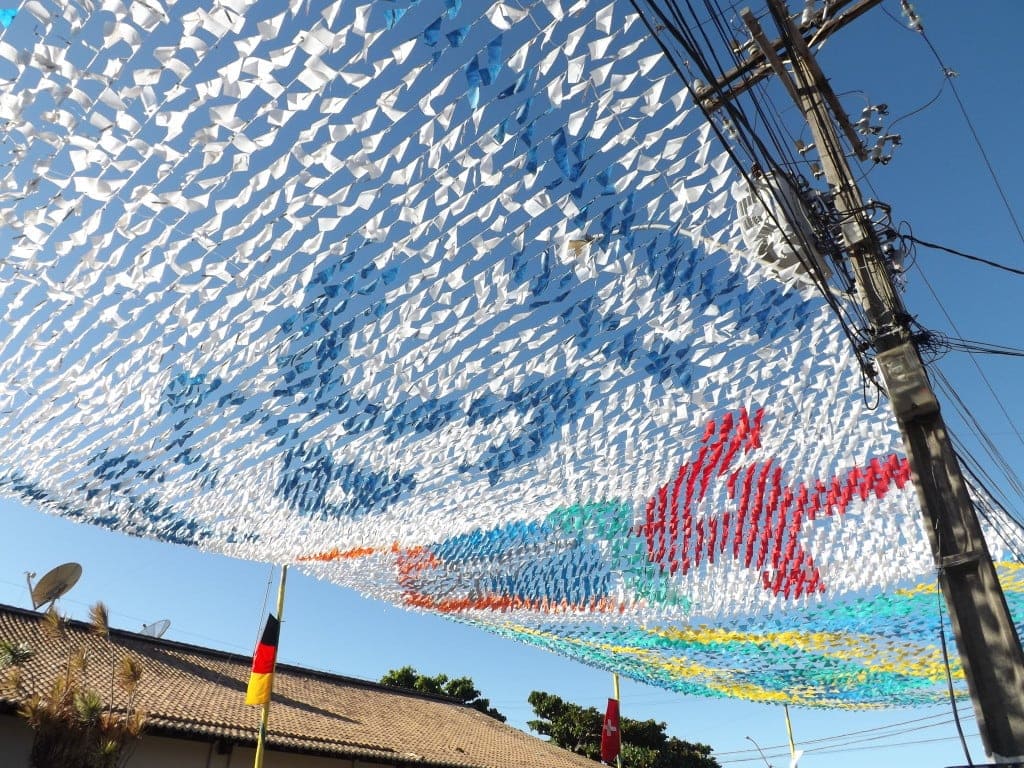
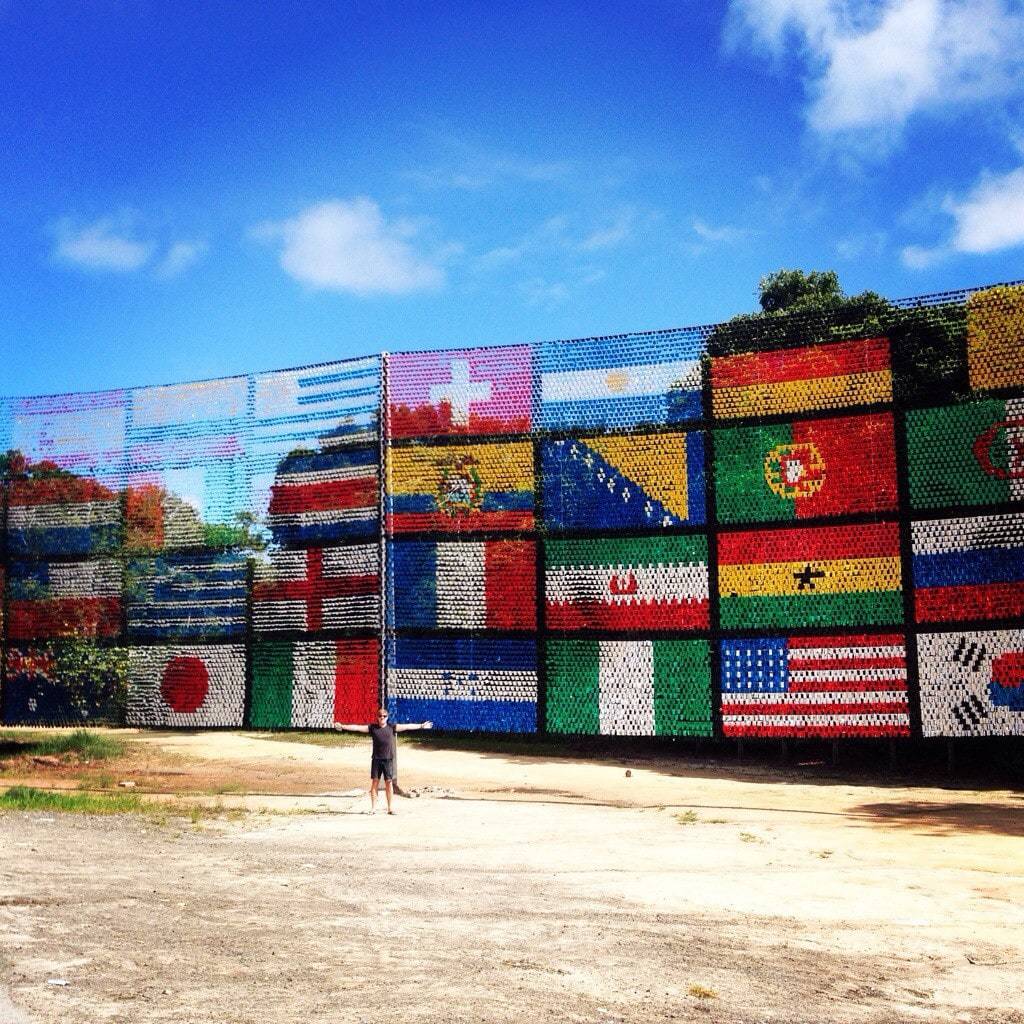
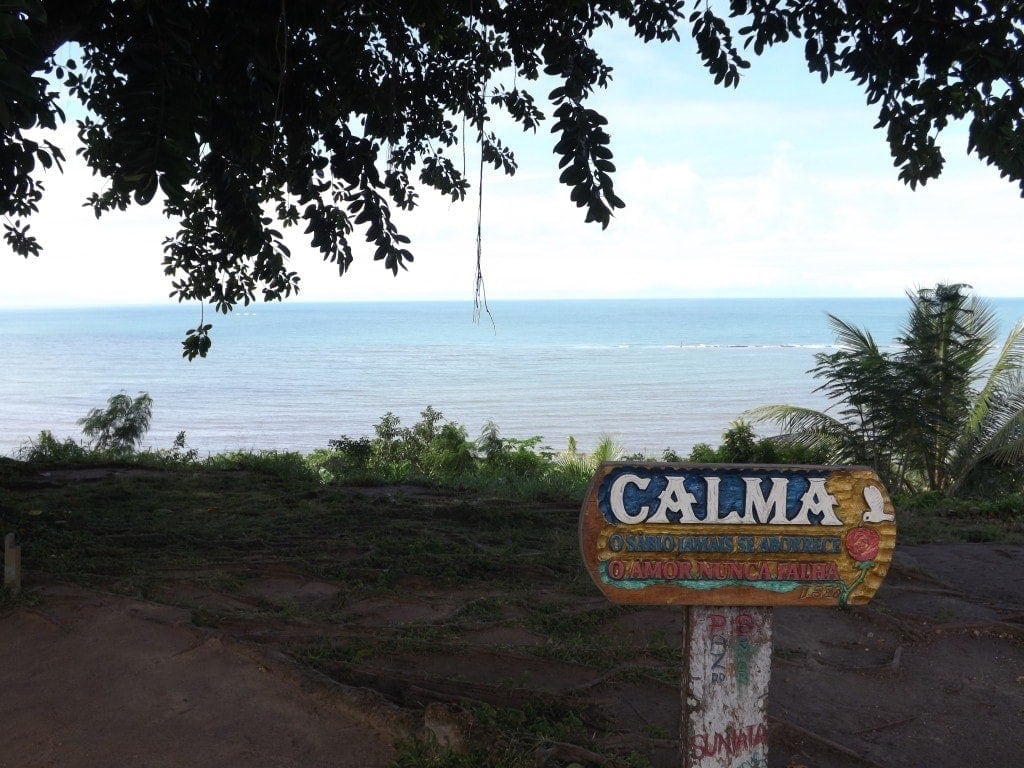
Without realising it, Sam and I had wound up in one of the more historically significant parts of the country. Porto Seguro marks the spot where Portuguese explorers landed on the continent and founded what would later become it’s biggest country. Just outside of town we discovered a small, half-forgotten memorial which included a model of the discovery ship, marooned at the foot of rich, reddish cliffs amid tropical trees and a narrow beach dotted with small rivers feeding into the sea. On our first afternoon we walked along the coast as far as this memorial, taking in the gloriously empty beaches and beautiful scenery which made us fall completely in love with Porto Seguro.
We also walked around the town, between the shabby, pastel-coloured buildings whose peeling paintwork and faded wooden trim looked like a conscious design choice. The Lonely Planet’s online guide to the town has a particularly evocative description: “Due to the city’s raucous nightlife, the streets are quiet and even rundown during the day, as though the whole city is experiencing a hangover the morning after the party”.
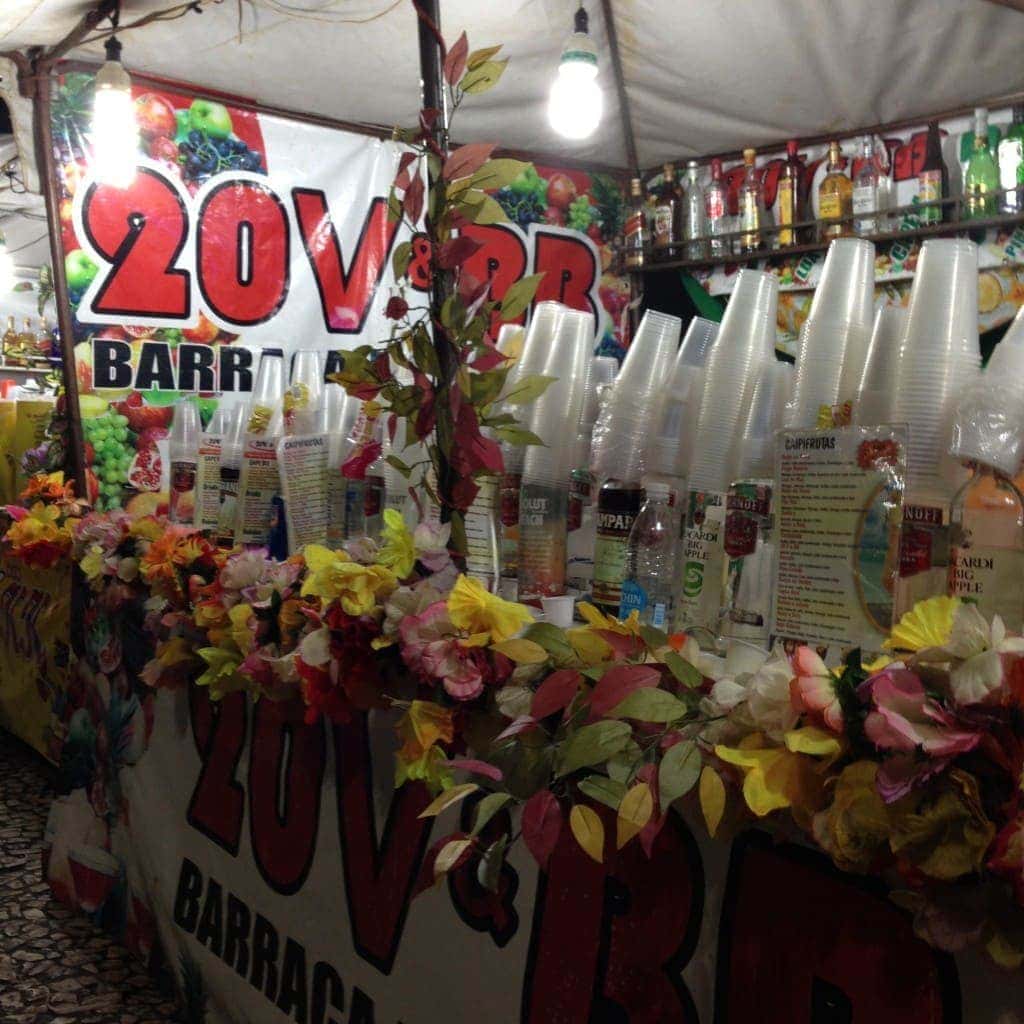
It being off-season, we didn’t get to experience too much of the nightlife, but luckily for us Porto Seguro’s star attraction runs year round, come rain or shine. The Passarela do Alcool, which roughly translates as ‘Alcohol Alley’, is exactly what it sounds like; a long strip of stalls along the sea front acting as miniature cocktail bars. There are souvenirs, handicrafts and plenty of food stalls in the marketplace too, but the highlight are the bars, which sell – among a full and varied list of concoctions – dozens of flavoured variations of Brazil’s signature drink, caipirinha. No one can make it through the alley without being coerced by one of the many women proudly stood in front of their stalls with a tray of tasters into at least trying a sip of one of the various cocktails on offer, and once tasted it’s also pretty impossible not to sit down and order one or two (or three, or four…). The stalls are lined in front of touristy restaurants which often provide live music, so our open-air bar had a running soundtrack. Although we spent a couple of nights on Alcohol Alley, sampling creamy cocktails and browsing the market, we didn’t see too much evidence of “raucous nightlife”.
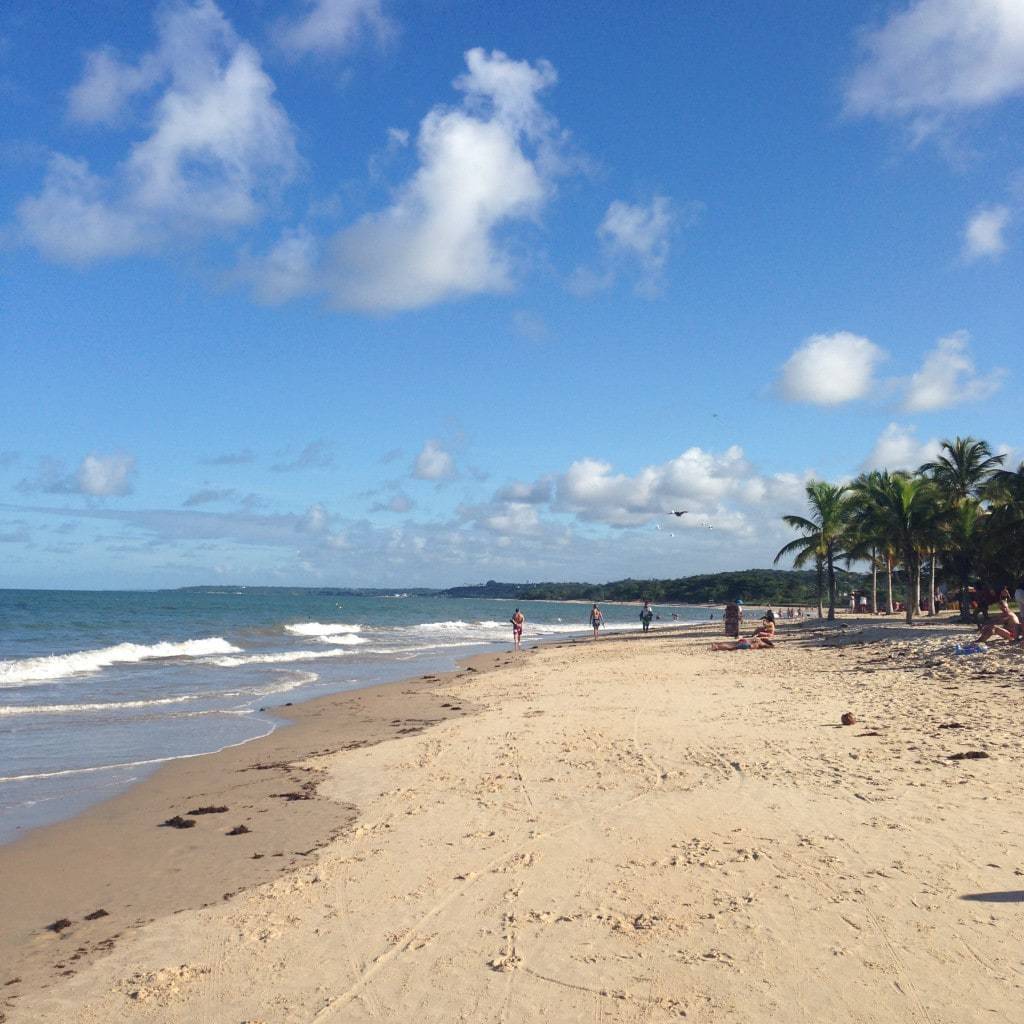
Our time in Porto Seguro was mostly whiled away exploring the incredible beaches which stretch along the Atlantic coastline on both sides of the town. A short ferry across the river took us to Arrairal D’Ajuda, just south of Porto Seguro, where we found a gorgeous stretch of beach. Pale sand, clear water and palm trees, backed by lush green hills. Close to the ferry port, the beach was covered in seaweed and the rocky water didn’t look great for swimming, while much of the beach further on is unofficially owned by the hotels which back onto it – meaning that those stretches are heaving with tourists, restaurants and bars – but we kept walking for about an hour or so until we reached a relatively secluded corner just across a small steam from the nearest hotel.
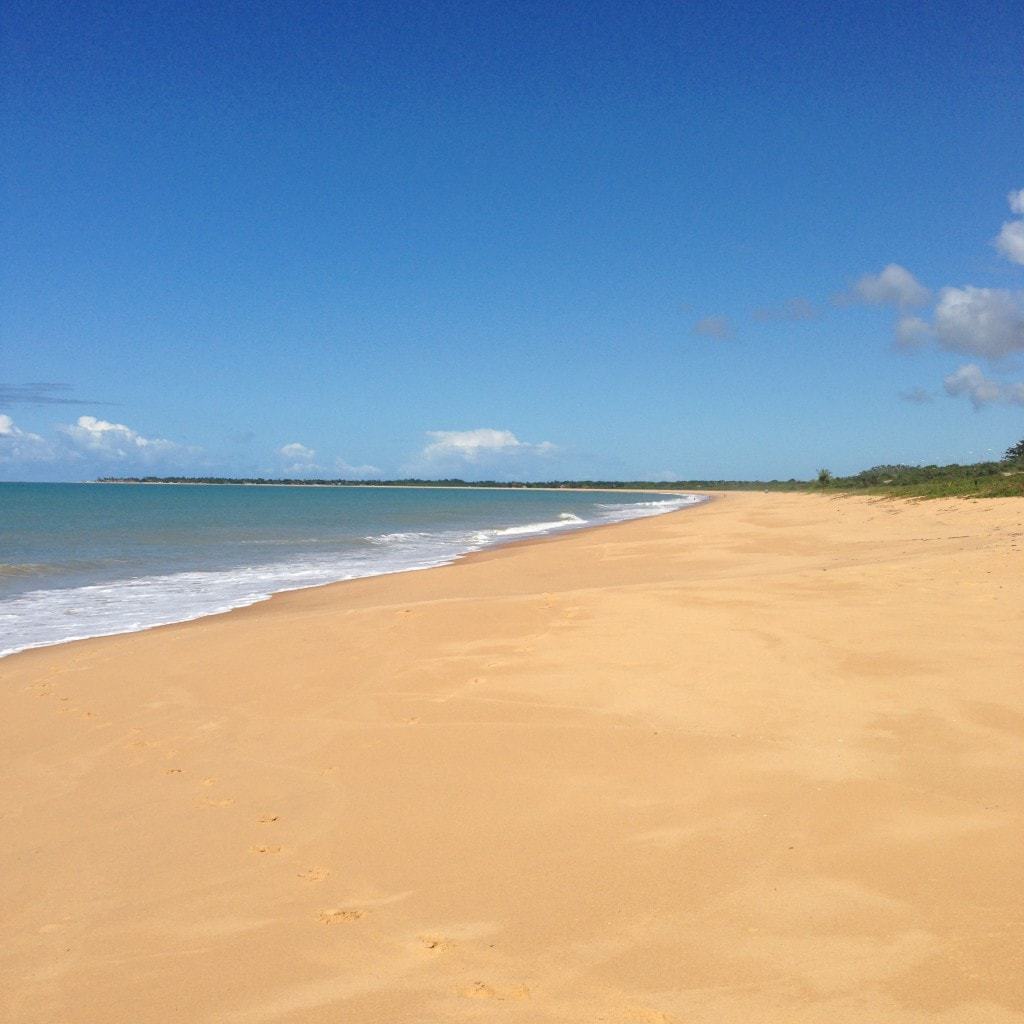
On the northern side of town, a 25km stretch of coastline between Porto Seguro and Cabralia has dozens of pristine beaches. We visited Mundaí twice, enjoying the lively beachside resort which showed World Cup games on a big screen and played music – or cheesy, Butlin’s style live entertainment – the rest of the time. But the absolute highlight was Mutarí, which we found after taking a bus up the coast and getting off at random seemingly in the middle of nowhere, and which we had almost entirely to ourselves. In fact, there were no other humans in sight for at least a mile in either direction, and we were so secluded that all we could hear was the wind and the crashing waves.
It being an Atlantic coastline, these waves were pretty big at all the beaches we went to, meaning we had a fantastic time burning off the enormous, cake-filled breakfast our hotel provided every morning by leaping over the crashing surf and trying not to get completely rolled over.
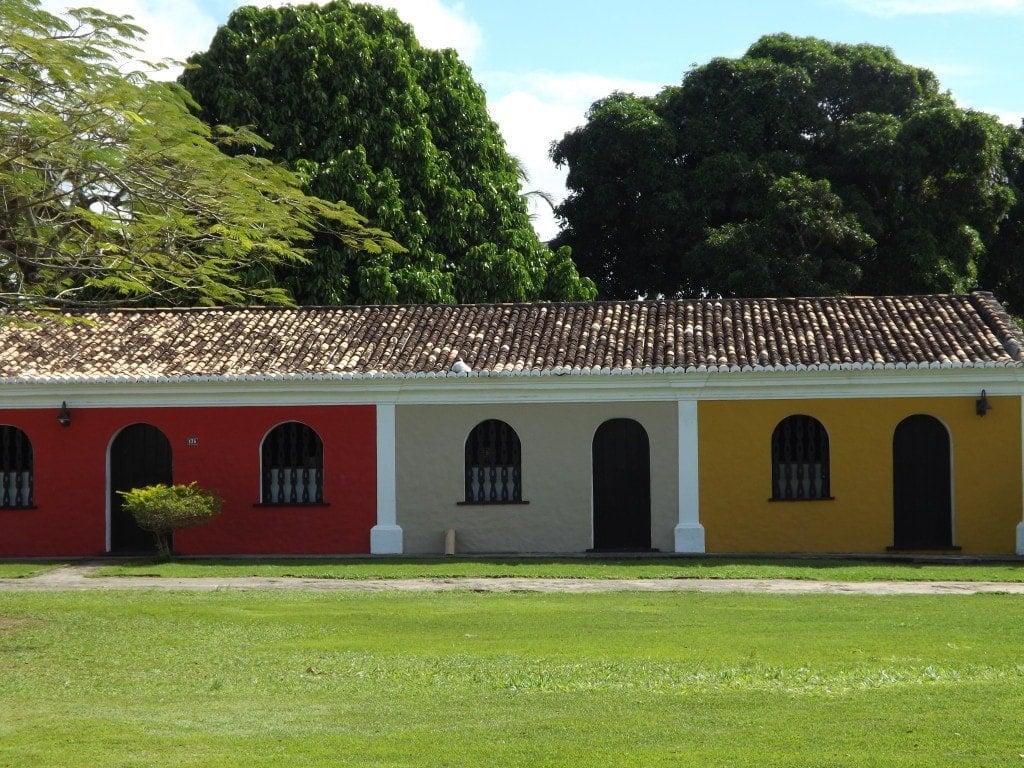
Beaches aside, there wasn’t a whole lot to interest travellers in Porto Seguro other than the pretty, colourful Centro Historico – a very touristy strip of brightly painted buildings and white colonial churches, which sits at the top of the green hill overlooking the town. But, after months of travelling we were in dire need of a place to rest our weary bodies – and even wearier finances – plus we were starting to wind down as we drew ever closer to the end of our trip; so we found ourselves holed up in Brazil’s first town for over a week, doing little other than swimming, eating, relaxing, and drinking.
Paraty
4th – 10th July 2014
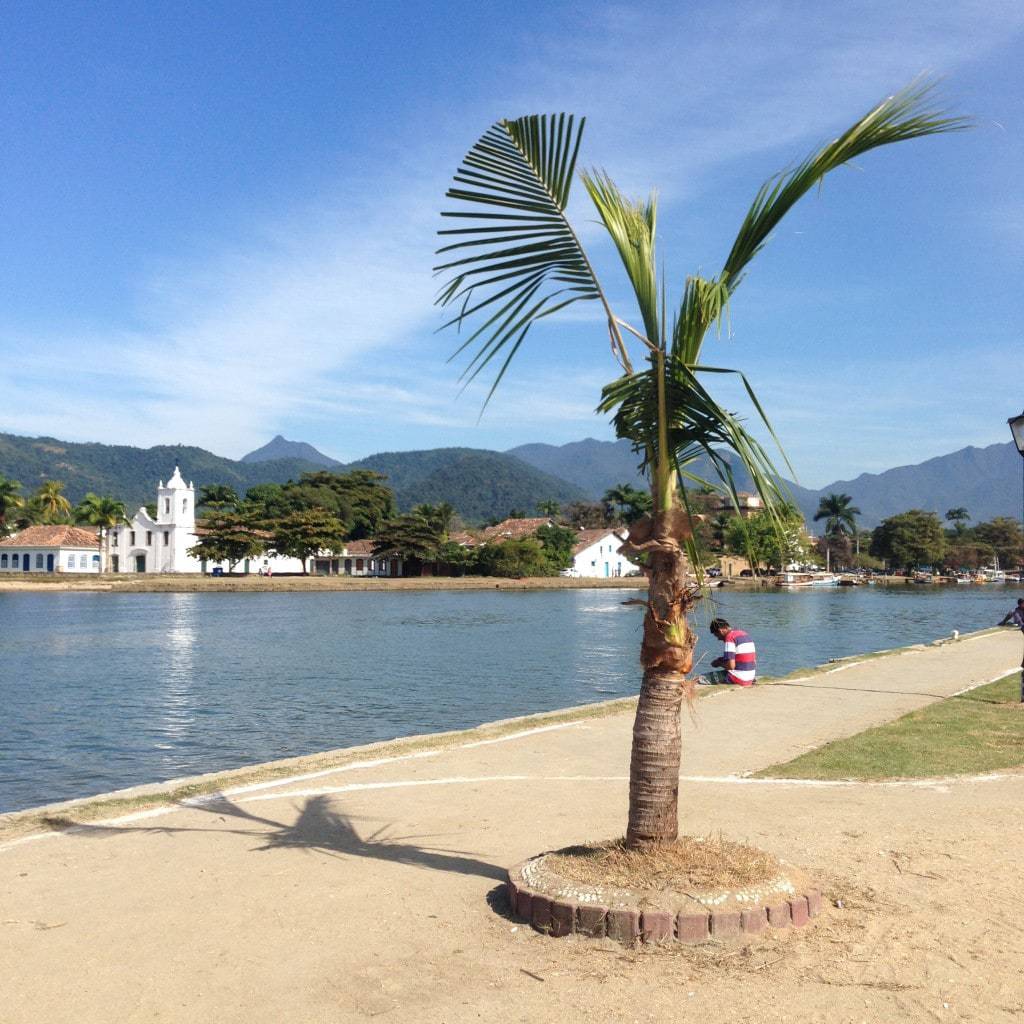
The fourth stop in our Brazil itinerary, Paraty, was a bit of an odd choice given our current northern location, but, as I mentioned before in my Porto Seguro post, our route was somewhat misshapen since our destination choices were dictated by budget, with the World Cup price inflation forcing us to seek out the towns with the cheapest accommodation.
From Porto Seguro, we had originally planned to head to Vitoria and the surrounding national parks before reaching our final stop of Rio. But, thanks to it’s proximity to the capital and the World Cup Final, prices in Vitoria were way beyond our backpacker budget, so our only choice was to take one last ridiculously long bus ride south of Rio de Janeiro to the backpacker towns whose prices hadn’t been too badly affected by the football.
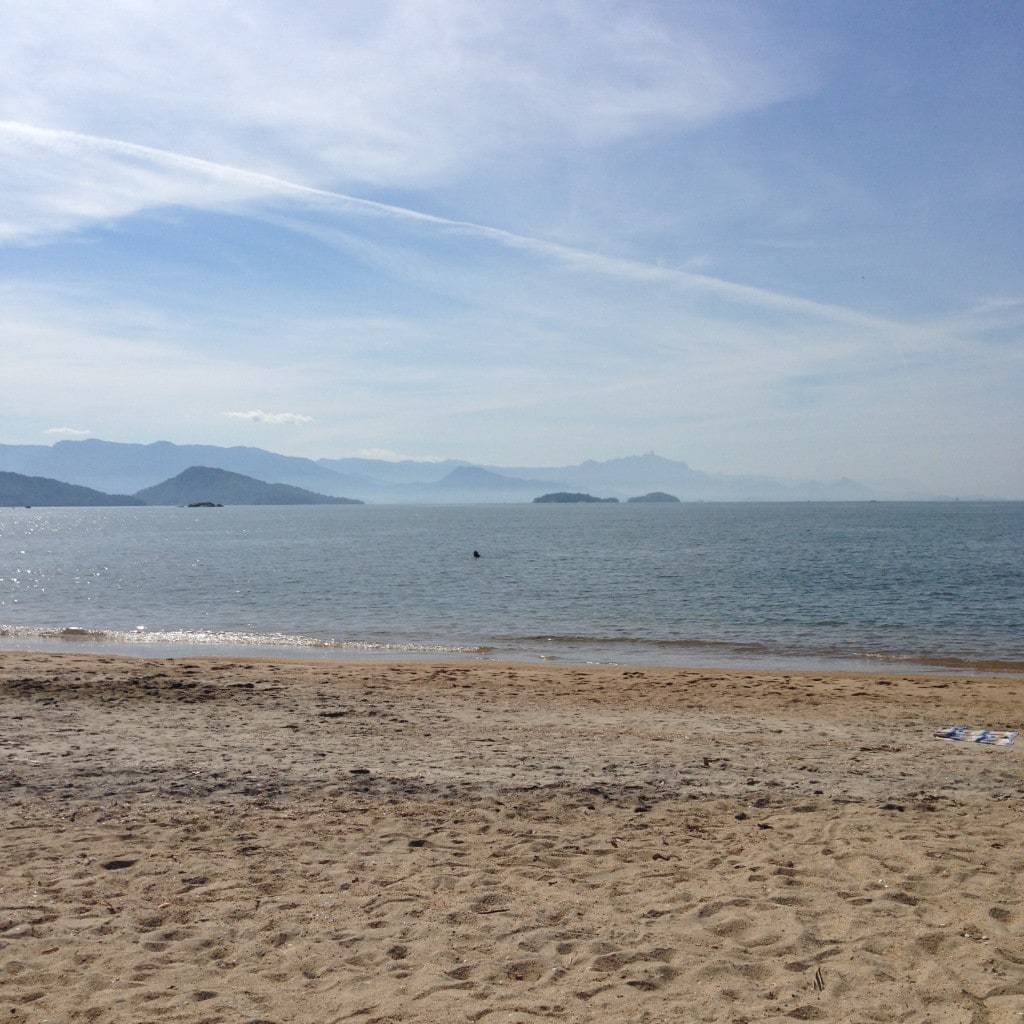
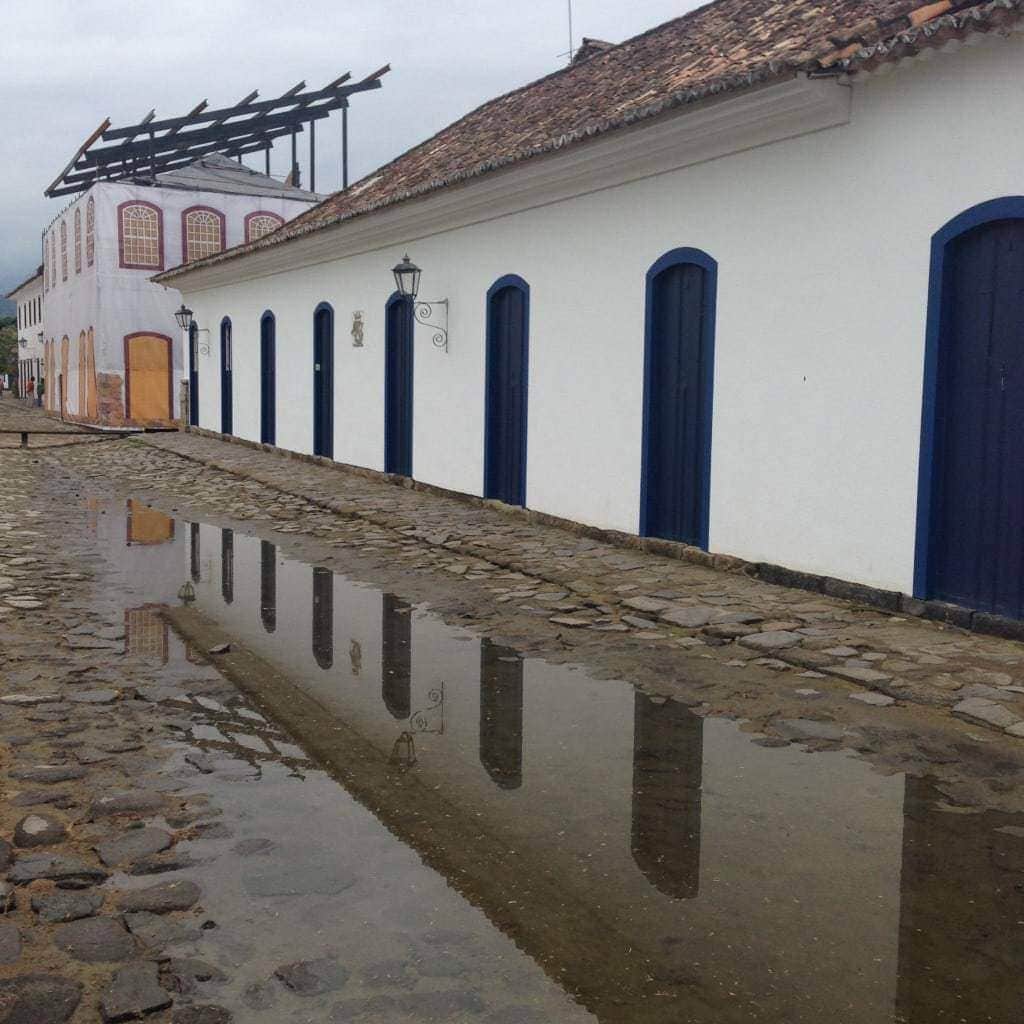
We wound up in Paraty purely because it was nearer to Rio than Florianopolis and avoided us an extra few hours on the bus. Not always the best way to choose a destination, but luckily we discovered in Paraty the perfect place to spend the penultimate week of our trip.
A backpacker haven with cheap accommodation, plenty of tours and restaurants with English menus, it also boasted a beautiful historic centre of pretty colonial buildings, and a gorgeous setting combining the rugged Atlantic Forest with dramatic coastline and postcard-perfect beaches.
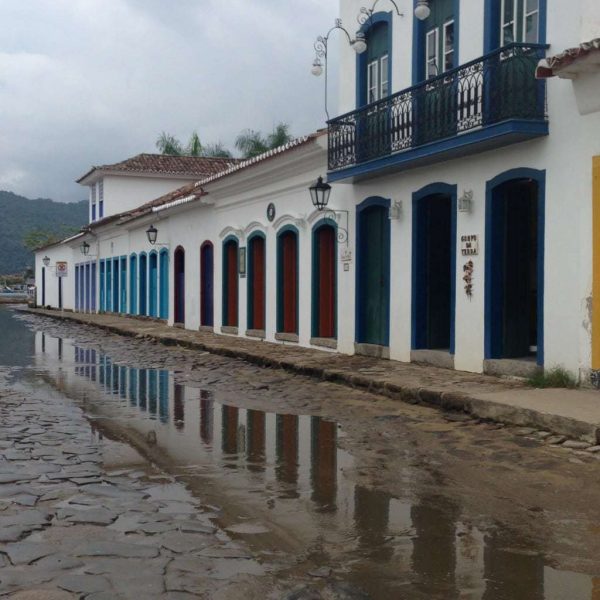
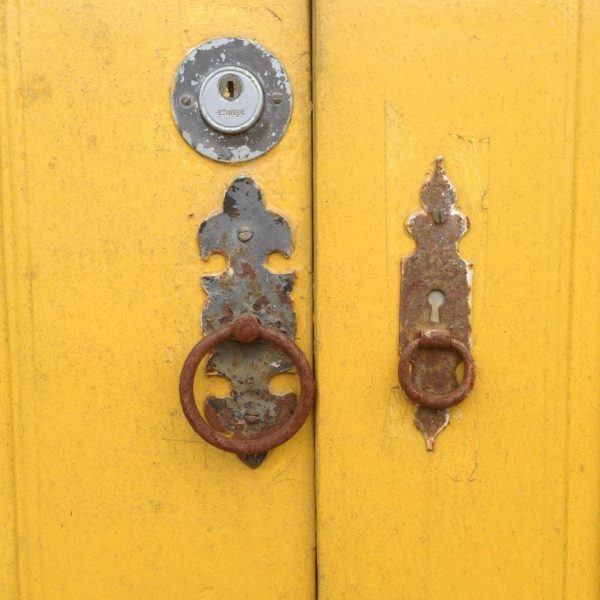
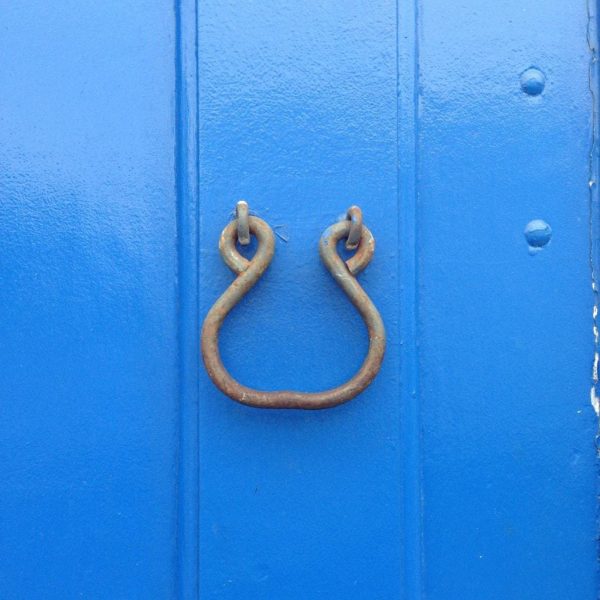
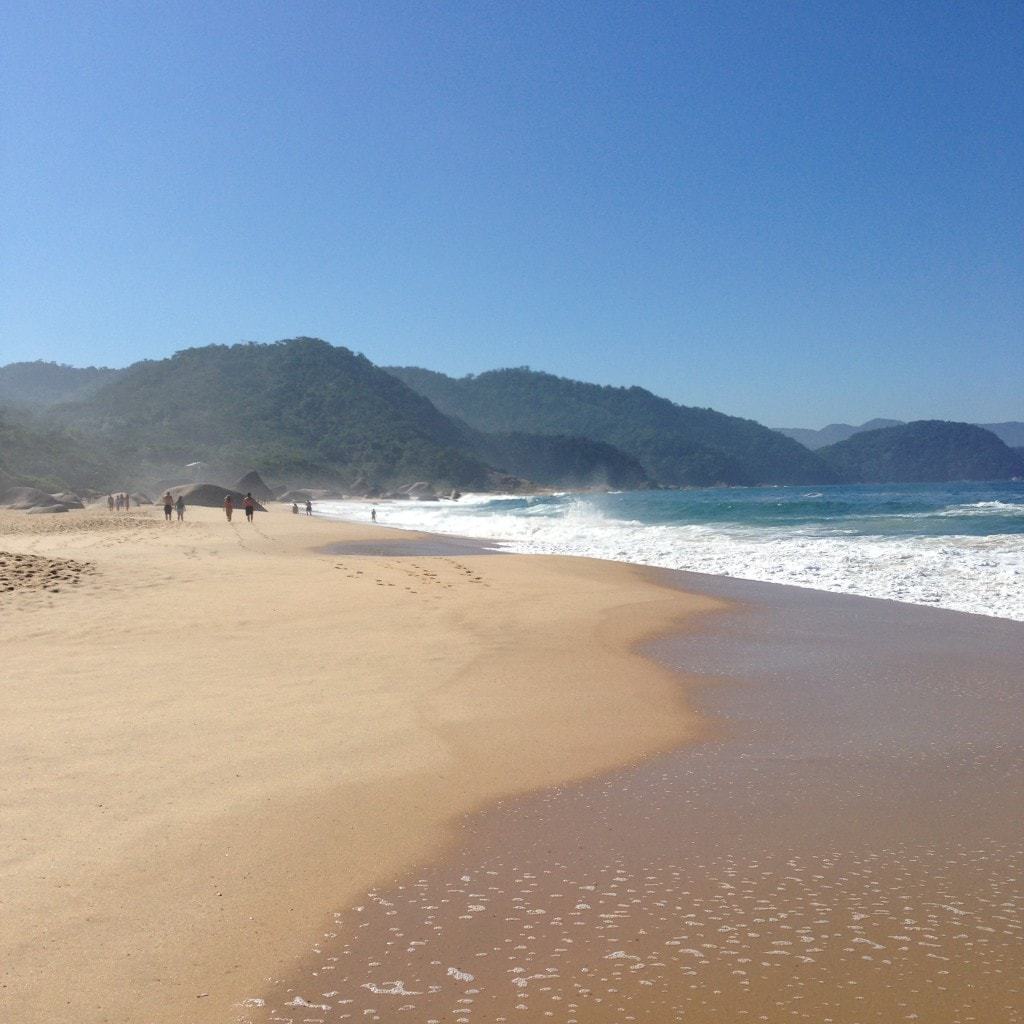
Being back in a hostel again was a bit of a shock to the system after our “mini holiday” in Porto Seguro, but luckily the one we found was nice enough. Besides, we didn’t stay in too much, as there was so much to explore.
We started, of course, with the beach. Acting on a recommendation from our hostel receptionist, we took a bus to Trindade, about 40 minutes down the coast, where we discovered a small bay at the foot of an enormous, forested hill.
Turquoise waters, sea-smoothed rocks, islands out in the bay like big humped back turtles, all pinned in by towering emerald hills and a forest of wiry branches and rubbery leaves. It really was one of the more beautiful beaches we’ve discovered on our trip.
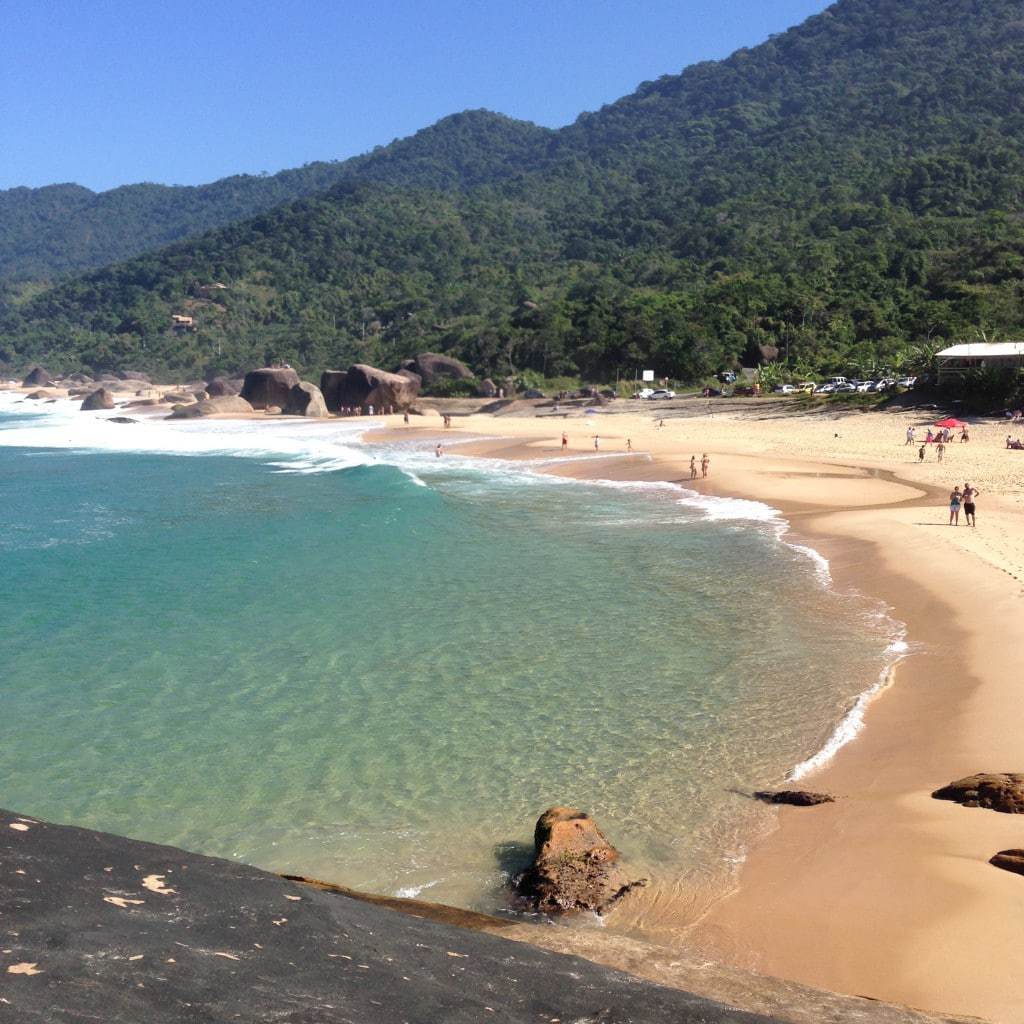
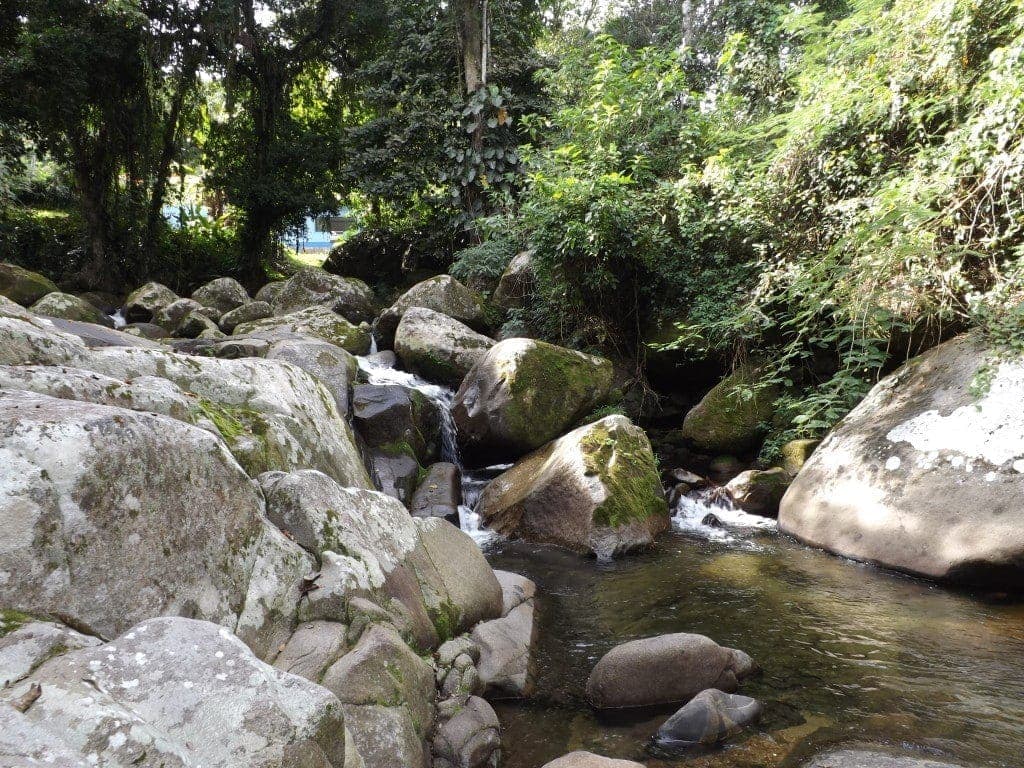
The following day, we headed into the forest on the hunt for waterfalls. There are dozens in the area surrounding Paraty, some more easily reached than others, but of course the easiest to find are the ones that all the tourists go to. We wound up first at Penha, where a short walk through the rich Atlantic forest, full of the smells damp moss, bark and big tropical leaves, brought us to a long wooden bridge over the shallow river which led to a strategically placed restaurant alongside a small, trickling waterfall.
The real highlight here isn’t the fall, but the huge natural slide further along the river; a big slab of slanted and perfectly smooth rock along which a thin layer of river flows, leading to a short drop into a very cold natural pool. Unfortunately, the Brazilian winter had finally caught up with us, replacing the sunny blue skies with clouds and drizzle, and while the day was very humid it was most definitely not hot enough to swim in such icy water. We gave the slide a miss and instead explored along the rest of the river, clambering down mini cliffs and over rocks as far as we could go to another tiny waterfall further along which was completely secluded.
On the way home, we experienced a fantastic example of the wonderfully welcoming nature of Brazilian people. Not sure when the next bus might be, we were walking along the road toward Paraty while waiting for one to appear, but after about an hour of walking it still hadn’t materialised.
As we trudged wearily back toward town – still about another two hours away – a completely lovely lady in the world’s smallest car pulled over and insisted (in loud Brazilian and mime gestures) that she give us a lift, to the total mortification of her teenage son.
We climbed into the back and squeezed ourselves into one seat next to a tiny dog which was taking up the other one. Our conversation was pretty limited, as neither me or Sam speaks Portuguese, but the lady was really friendly and it was a fantastic reminder that there is still generosity and kindness left in the world!
We discovered one more swimming hole a few days later, on the recommendation of Hans, the lovely owner of the Shambhala Lounge where we had lunch. The Poço do Inglês, or Englishman’s Well, is a very secluded spot which was much less busy than the fall at Penha.
We had to walk along a winding, muddy track through tangled forest to find it; a deep, clear pool in a small clearing with a tiny, tinkling waterfall and a big rope swing over the water. This took a lot of work to get hold of – we had to use a long and very heavy branch to hook the rope and pull it in – and it also took quite a lot of work to get me to actually take the leap and jump. In the pictures, it doesn’t look that much of a drop into the pool, but from where we were stood on the rocky ledge overlooking the pool it felt very high. Once I took the plunge, it was so much fun – in spite of the seriously cold water.
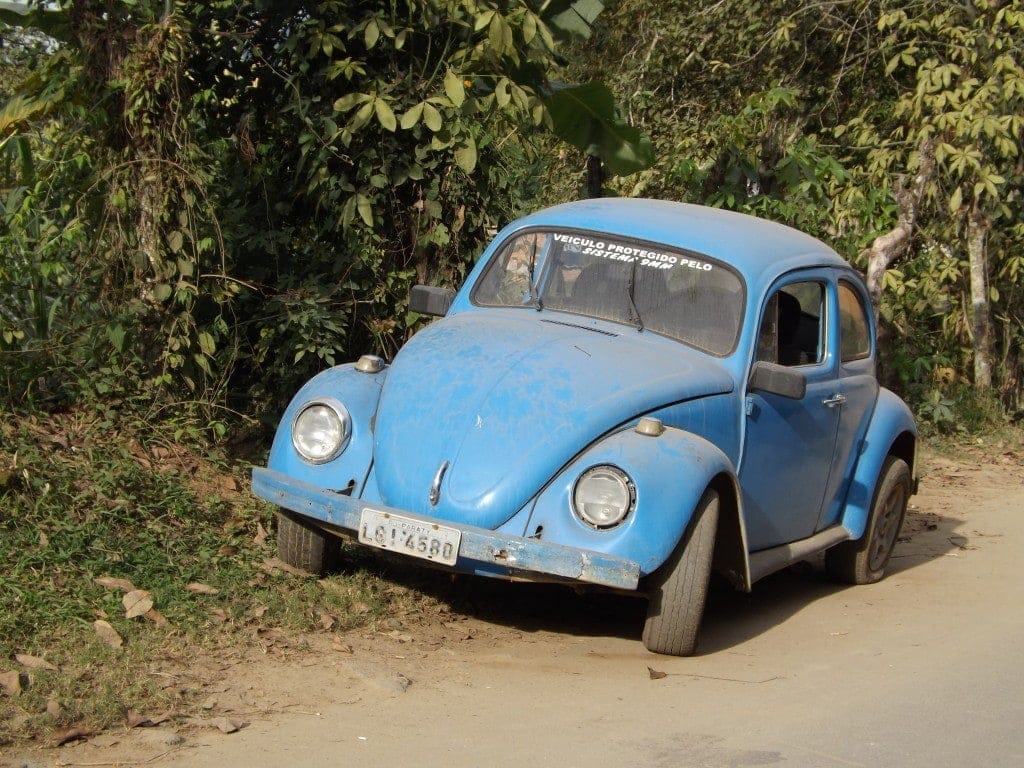
I’ve already written about everything else we did in Paraty in a series of separate posts, but in case you missed them… we watched the World Cup semi-final with all the locals on a big screen in the town centre; we headed into the forest for a tree-top adventure with Paraty Sport & Aventura; we sampled cachaça at one of the many nearby Alambiques, and I finished the week off with a wonderful treatment at the heavenly Shambhala Spa. It was a fantastic week and I could have stayed much longer if Rio, and the last week of our five month trip, hadn’t been calling.
Exploring Rio de Janeiro and Watching the World Cup in Rio
10th – 17th July 2014
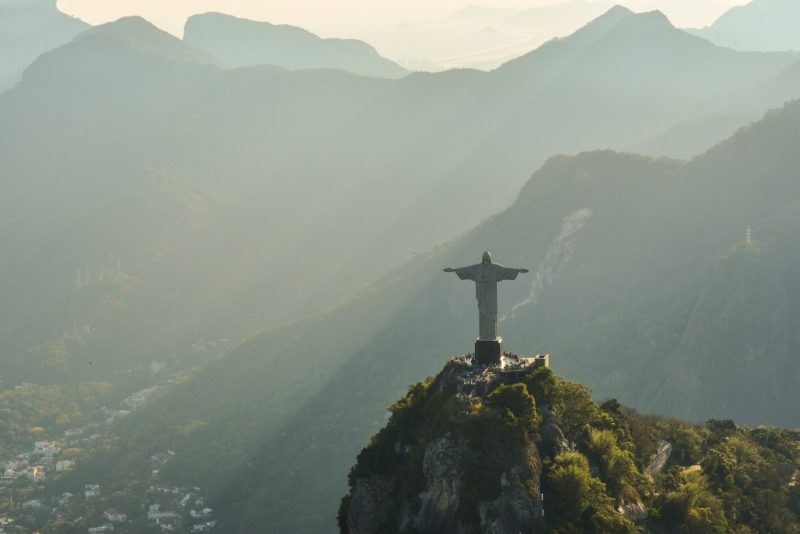
The final week of our five-month South American Adventure was spent in Rio de Janeiro, one of the most colourful, fascinating, and enticing cities I’ve yet discovered.
We were there over the weekend of the World Cup Final. Rio’s normal party atmosphere was overwhelmingly amplified by the football fans who had gathered in their hundreds of thousands to watch the game.
Over our week in Rio, we managed to explore a fair bit of the absolutely enormous city, from the chaotic slums of Rocinha favela to the glossy city centre and those famous white-sand beaches of the seafront.
Hitting the Beach
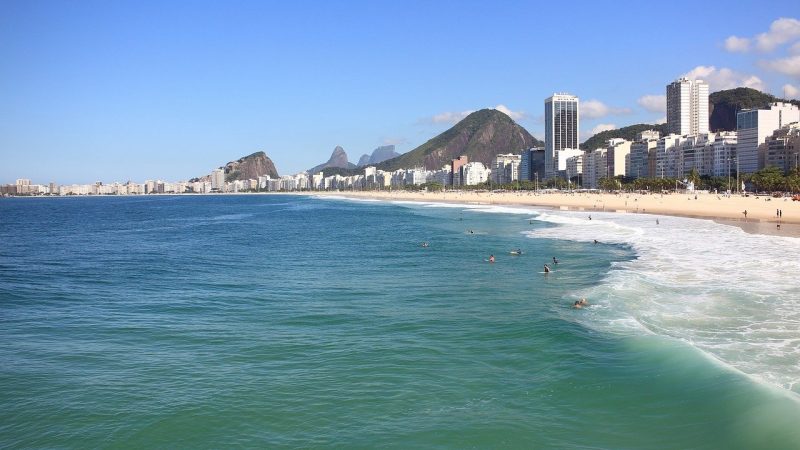
Copacabana Beach was rammed with both tourists and football fans. As soon as I arrived, I spotted the unmissable FIFA Fan Fest which dominated the serene stretch of white sand. The nearby FIFA souvenir store felt like Disneyland and housed an explosion of plush toys, baseball hats, football shirts, as well more obscure souvenirs like cheese boards and the official World Cup wine. Even if the prices had been a bit more affordable, there is no way I would have braved the impossibly long queue to buy anything. I couldn’t even find the end of it!
We spent the rest of that day strolling along the esplanade, marvelling at the crowd-dodging joggers and the crazy-fit guys doing pull-ups at the outdoor gyms. Eating lunch at one of the many cafés lining Copacabana beach, it struck me what a contrast this luxurious, modern district made with our experiences in the favela, where we were staying. Rocinha Favela was only an hour by bus from Copacabana, but it might have been a different world.
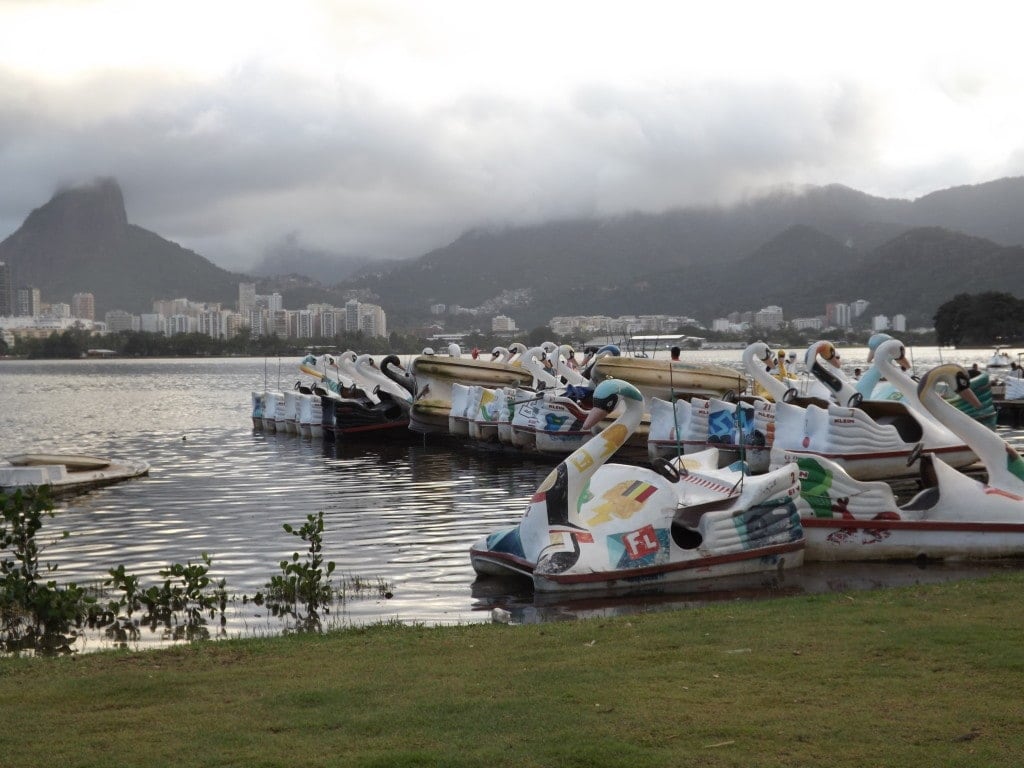
World Cup in Rio
On Sunday, we were back on Copacabana for the 2014 World Cup Final. That day, the beach was so overrun we could barely see the sand around the FIFA Fan Fest area. We arrived early and managed to secure a fairly good spot with a view of the second screen.
I was surprised to see an absurdly long queue for the fenced-in area housing the first screen. Both screens were the same size, so there was no real reason to get inside the Fan Fest to watch the game, other than the prestige of saying “I was there”. For me, being in front of the big screen on Copacabana beach was exciting enough.
The atmosphere was incredible. We were completely surrounded by Argentinian fans, all of them wild with excitement; chanting and screaming as the game went on. I’m not a lover of football, but I can get involved when I’m watching a match with passionate fans. It also helped that at the start of the World Cup I’d placed a small bet on Argentina to win.
Some of the Argentinian fans near us had procured a cardboard cut-out of Neymar, Brazil’s star player, and dressed him up in an Argentina shirt. They held him high above the crowd. Everyone was in really high spirits… but of course it didn’t last.
Until the very end of the game, positivity and joy rang through the air. The thrill and pride of the Argentinian fans was palpable. The volume of it reverberated through me, along with their shouts and cheers. I couldn’t help but feel as crushed as they did when Germany won.
Santa Teresa

Rio de Janeiro, we discovered, is an absolutely enormous city with dozens of different districts to explore. One of my favourites had to be the historic and bohemian Santa Teresa district up behind the city centre.
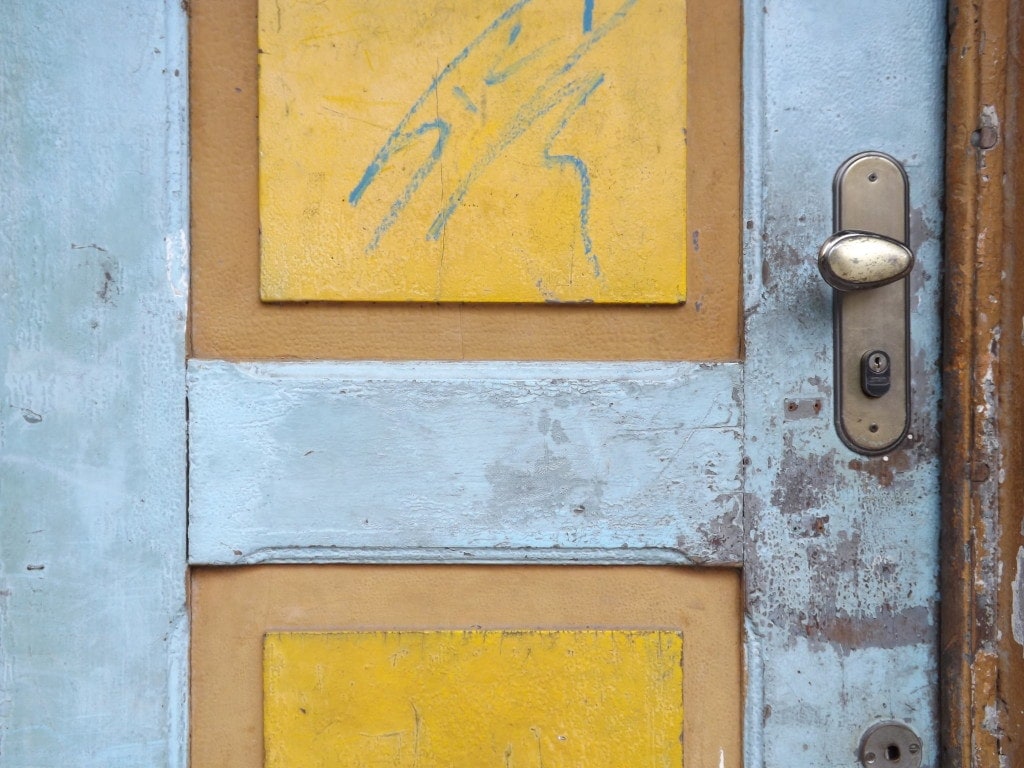
For one thing, the views were incredible. Once we’d made it, panting, to the top of the steep hill the neighbourhood is perched on we saw the enormity of Rio sweeping away beneath us to the sea, Sugarloaf Mountain towering in the middle of it all. We also had a great view of a nearby favela, surrounded by towering white apartment buildings, yet another example of the stark contrast between rich and poor that seems to run throughout Rio.
Once a glamorous upper-class neighbourhood, Santa Teresa is strewn with nineteenth-century mansions that have seen better days. We passed dozens of shabby, faded, but brightly-painted mansions and villas, many of them covered by trailing vines and flowers.
When the slums crept a bit too near, Rio’s rich and famous moved away from the city centre and Santa Teresa fell into disrepair. Dilapidated houses meant lower rent, so during the 1960s and 70s the area was claimed by the city’s artists, writers and musicians. As a result, Santa Teresa has a vibrant and bohemian reputation as an arts district.
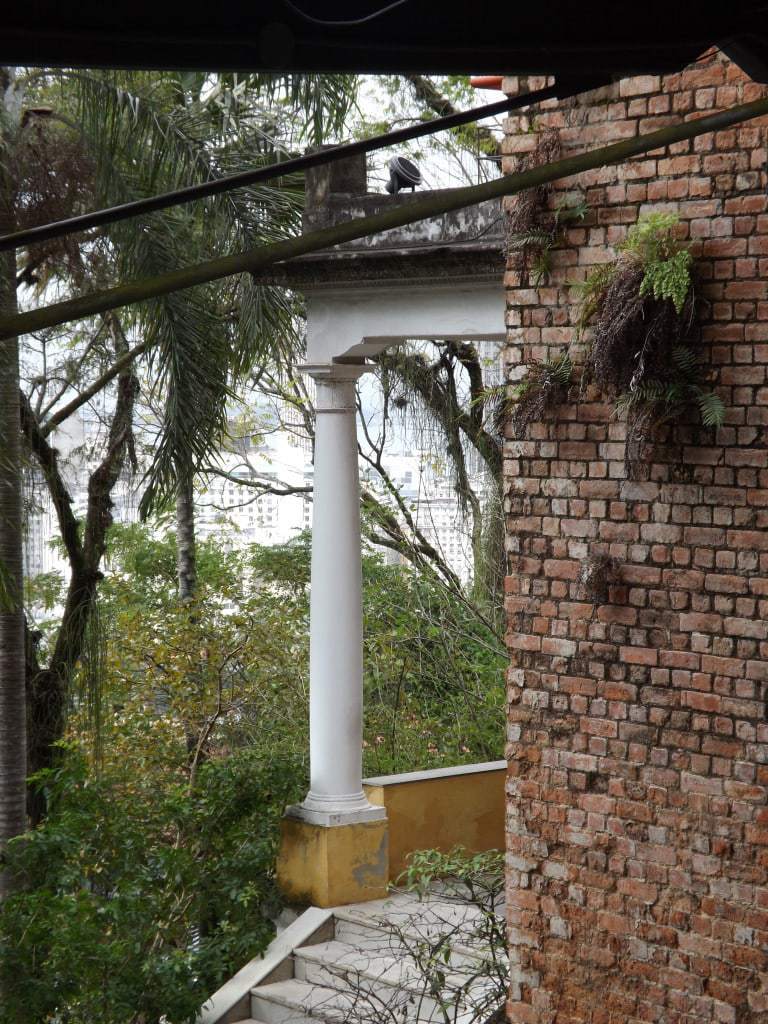
Many of the buildings have been lovingly restored, with numerous mansions now housing cool restaurants or shabby-chic bars, and there are dozens of art shops tucked into the pretty townhouses.
Sightseeing and Street Art
One old mansion that has remained untouched is the one-time home of Brazilian heiress Laurinda Santos Lobo, whose house was a salon for Rio’s artists and intellectuals in the 1920s and 30s. This stands in what is now known as the Parque das Ruinas, alongside the art museum Museu Chacara do Ceu. Today, Santos Lobos’ home houses art installations and open-air concerts in honour of its former role as Rio’s artistic hub. The gardens were rich and shady, and between the lush greenery we caught still more glimpses of the incredible views from on high, but sadly when we visited both the museum and the Parque das Ruinas (where the best views of Rio can be had) were closed.
Instead, we visited another ruin, the station of the old Bonde, Rio’s last remaining tram car system. It ran from Lapa to Santa Teresa until 2012. Today, the old station has been coated in street art recalling its glory days. Even up here, in this serene and stately neighbourhood far from Copacabana, World Cup fever had made its mark. A huge mural showed the Brazilian team riding away in a restored yellow tram car… while Messi (Argentina’s star player and Brazil’s arch-enemy) sobbed in the corner.
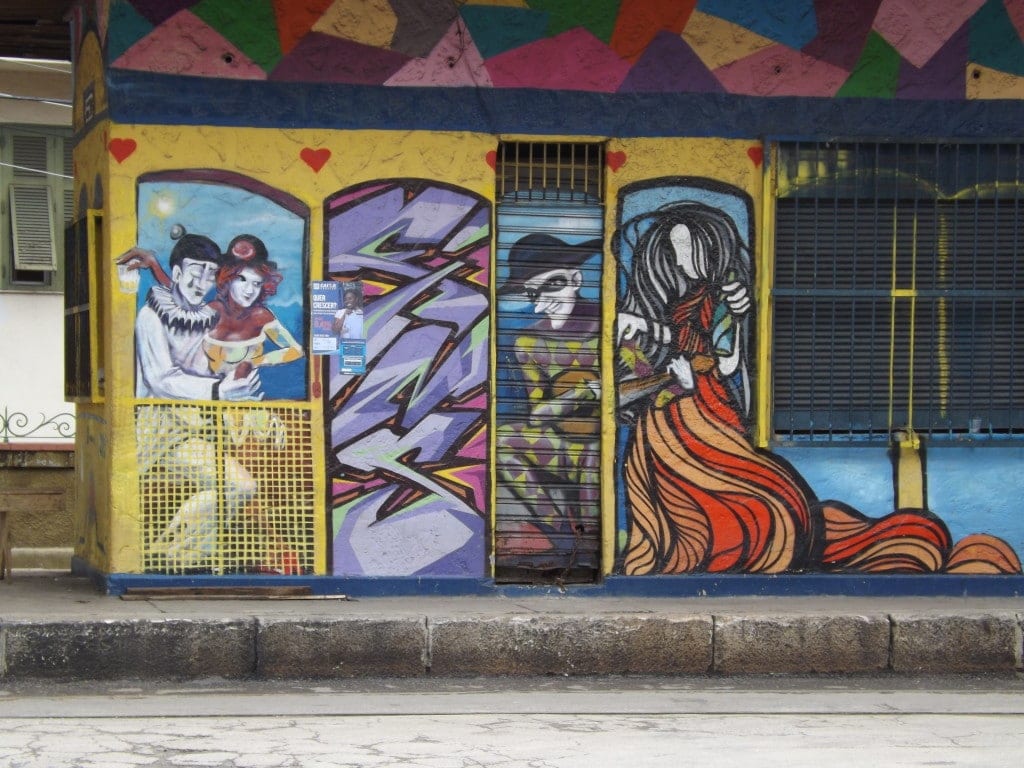
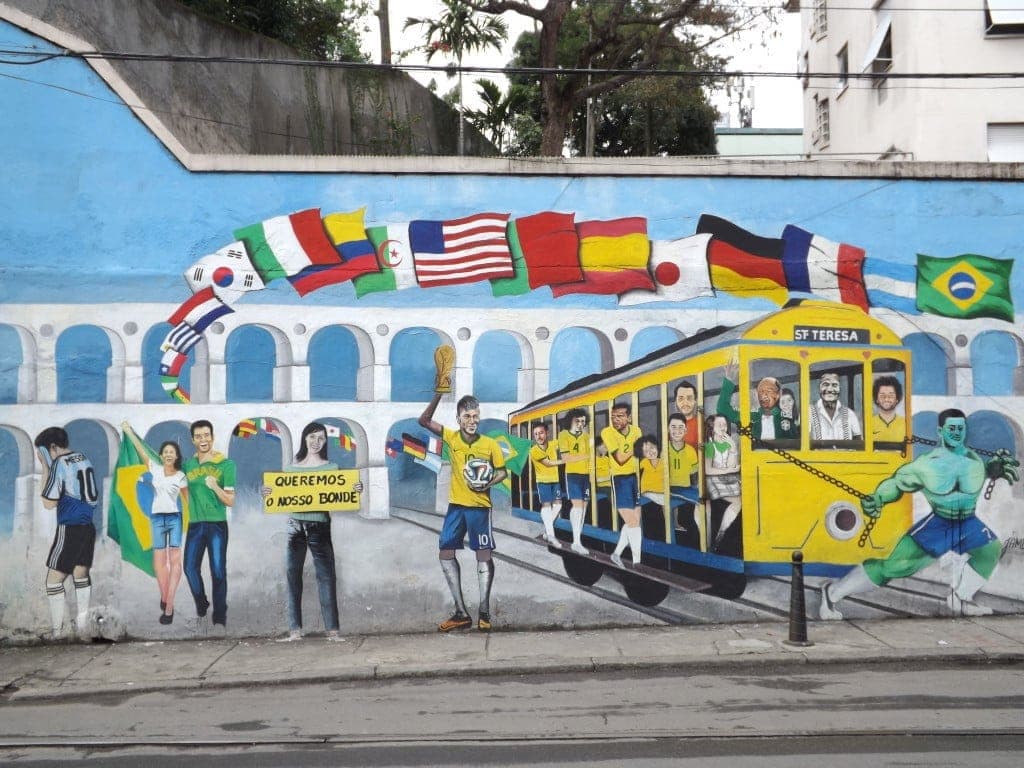
Lapa
We may have spent our first four nights in Rio slumming it in the Rocinha favela – thanks to the hugely inflated World Cup accommodation prices – but thankfully right after the weekend of the final match prices returned to normal. So we switched to a more reasonably priced hostel in the very centre of the city.
Lapa was a world apart from the hectic slums of Rocinha, and even more so from the glossy high-rises of Copacabana and Ipanema. A world of its own, Lapa was a beautiful, colourful neighbourhood of old buildings, lively bars and amazing street art.
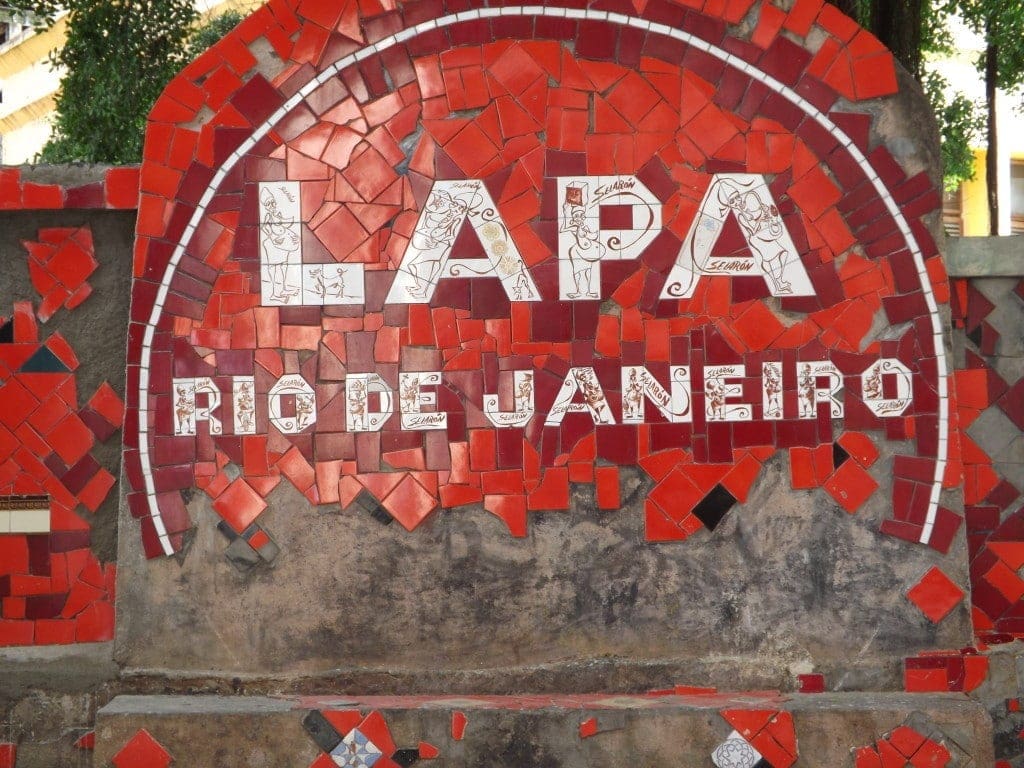
Lapa is also home to two of Rio’s most iconic sites. First the incredible Arcos de Lapa, an 18th-century aqueduct which once carried water to the city centre from the Carioca River.
This huge construction sits bizarrely between an ordinary office district of glass-clad high-rises and Lapa’s shabby-chic shuttered mansions, dividing two very different districts. Eye-achingly white in the dazzling sunshine, the Arcos de Lapa tower above a multi-lane highway, looking wonderfully out of place.
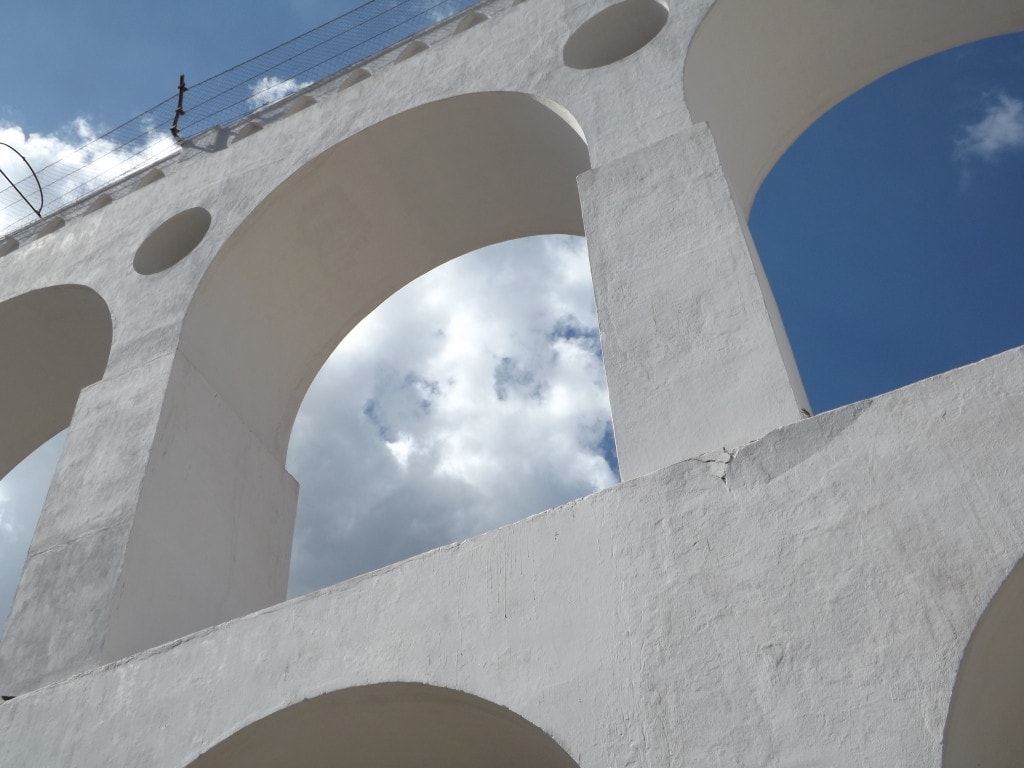
Selaron Steps
Not too far from the arches is Lapa’s main attraction, the popular Escadaria Selarón or Selaron Steps. This colourful and ever-changing piece of street art was the work of Chilean-born artist Jorge Selarón.
It occupies an entire staircase – as well the houses lining it – between Joaquim Silva street and Pinto Martins street. The whole staircase is covered in brightly coloured tiles, with the fronts of the steps clad in yellow, green and blue (the colours of the Brazilian flag) and the surrounding walls largely post-box red.
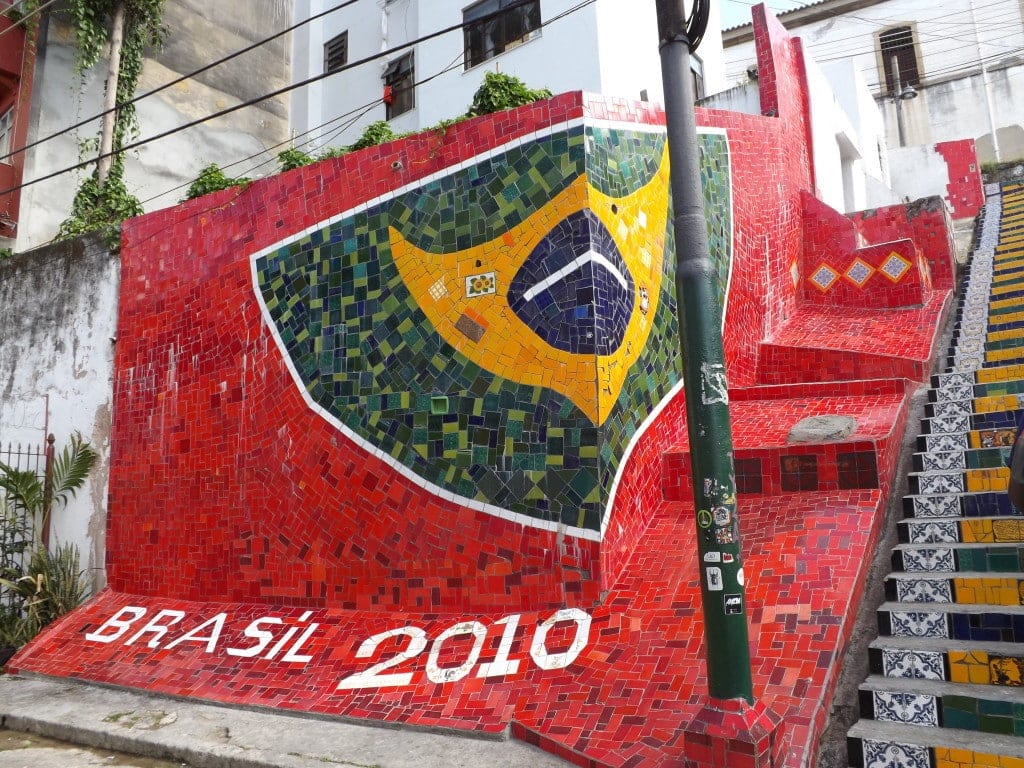
Selarón called the staircase his “tribute to the Brazilian people”. With 250 steps covered in over 2000 tiles, it’s a pretty big tribute. And he still hasn’t finished. Selarón regularly updates and reworks sections of the staircase so that the artwork is constantly evolving. Mixed amongst the coloured tiles are printed and hand-painted tiles from around the world. Some are painted by the artist himself, others were bought in shops, scavenged from construction sites, or donated by visitors. The overall result is delightfully eclectic, bringing together little pieces of art and culture from all over the world.
We originally visited the steps in the afternoon, fighting a huge crowd for photos in the burning midday heat. But, wanting to get just one shot of the staircase itself without a bunch of people posing for Instagram shots, we decided to return a couple of days later before breakfast. At 8am, the shiny tiles were dazzling in the morning sun, and we had almost had the steps to ourselves.
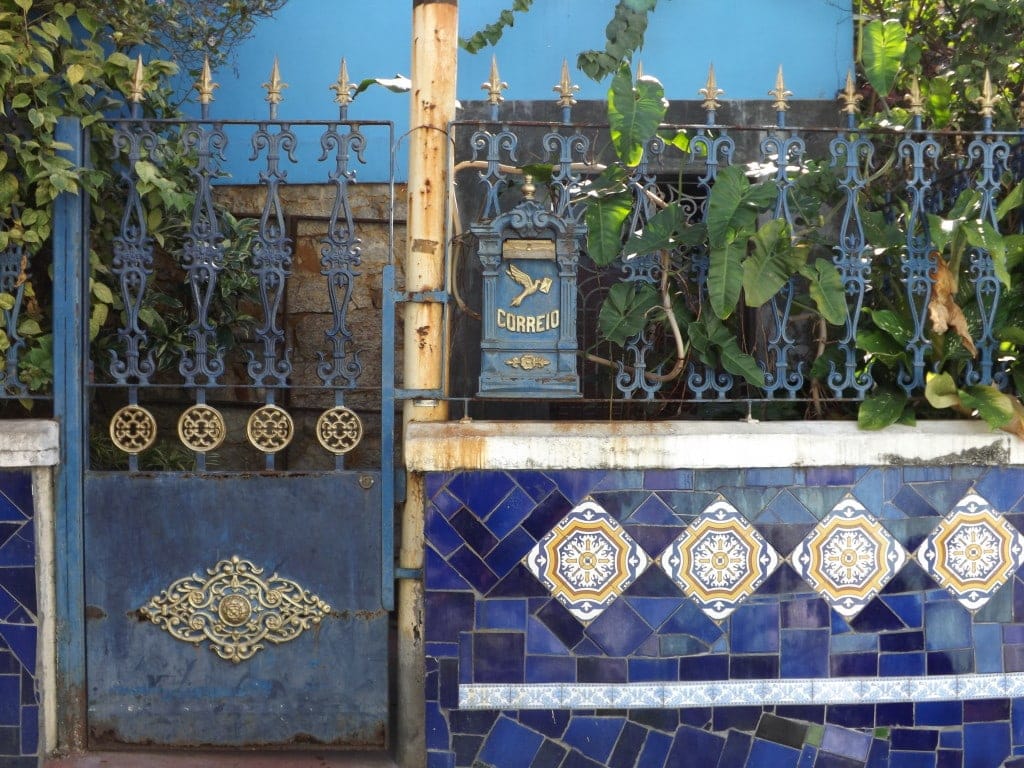
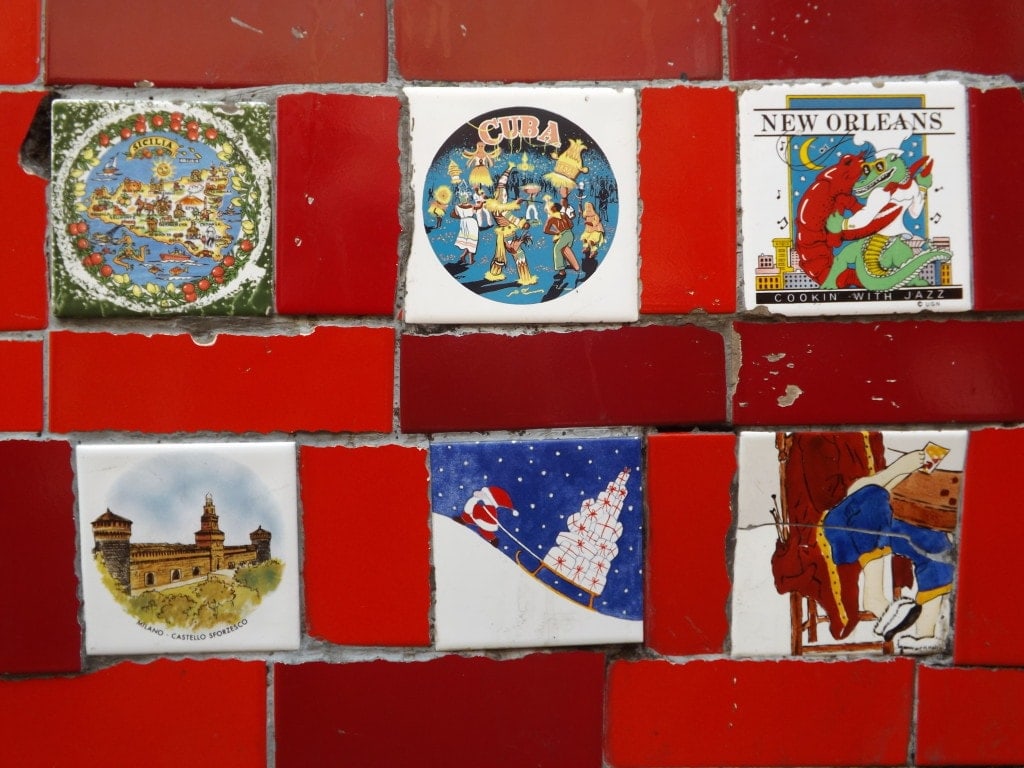
Parque Campo de Santana
One other place we visited in Lapa was the Parque Campo de Santana, the perfect place for a quiet walk just before sunset, where we could escape the hectic city traffic behind high fences. Inside, we found a huge, beautiful park with enormous willow trees and a pretty lake.
Historically, the park is pretty significant. It was the scene of the proclamation of Brazil’s independence from Portugal on 7th September 1822. But for us, the highlight was the park’s inhabitants: huge, hamster-like rodents called agoutis. These cute animals, native to Brazil, were all over the park, crowding in big, scurrying circles around piles of food which had been left out for them. The noise of their quick teeth working on the crunchy seed was surprisingly loud, and a rapid tapping seemed to fill the park.

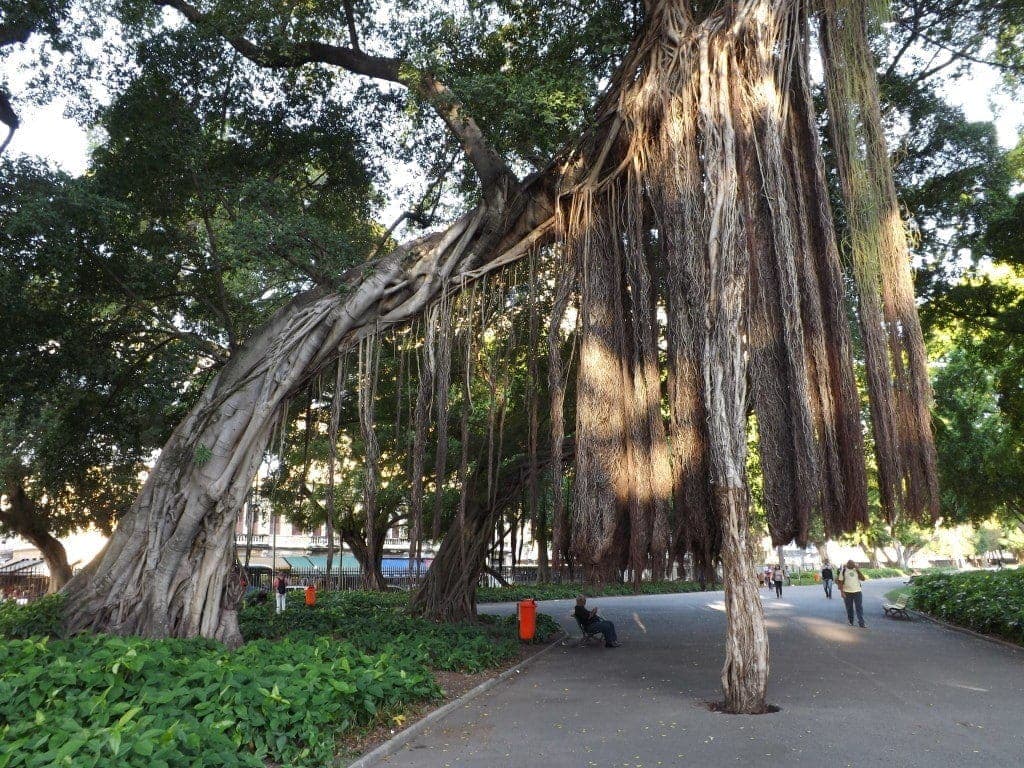
Lapa has a reputation as a party district, thanks to its heaving bars and late-night street parties, but it also had loads to offer during the daytime. Although it did feel a little dodgy in some areas (the neighbourhood boasts quite a large community of prostitutes), it was a really cool district with dilapidated but pretty mansions, great bars and restaurants, and so much amazing street art. It was an awesome place to spend the last few nights of our trip!
Christ the Redeemer
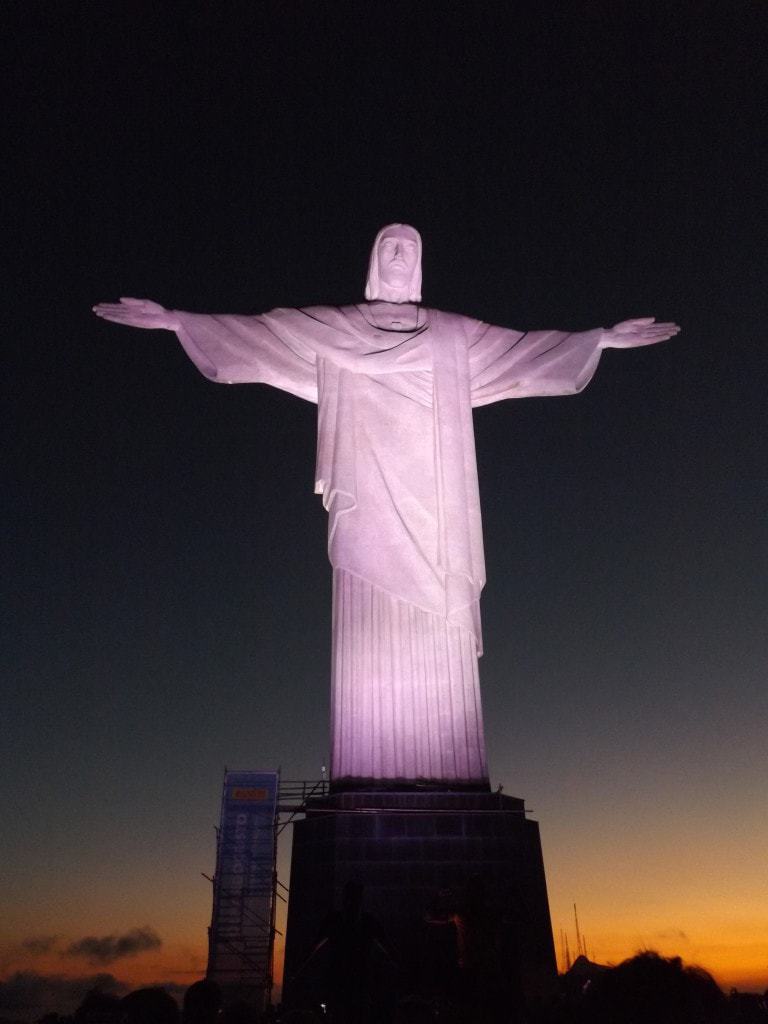
One of our final stops in Rio before heading back to the UK was the iconic Christ the Redeemer statue at the top of Corcovado. This is a serious tourist trap; overcrowded, overpriced and very over-done, but it also felt like the one thing we couldn’t miss in Rio de Janeiro.
We took the most popular route to the top; the very busy tourist tram. The Trem do Corcovado is so popular that we had to book our tickets a couple of days in advance (thankfully we could do that online, albeit slowly and with great difficulty).
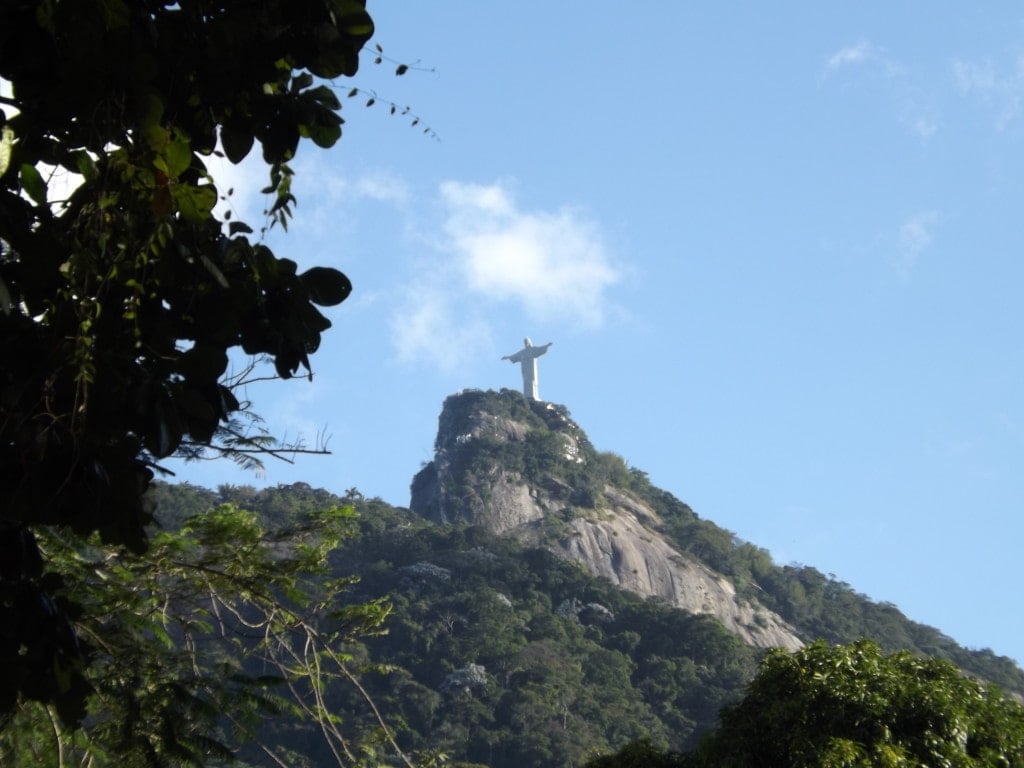
Inspired by that stunning sunset shot of Christ from the World Cup final coverage, I thought it might be nice to be up there to watch sunset. So we booked a train which should arrive just in time for sunset. Clearly, five months of experience in South America had taught me nothing. I failed to factor in “Brazil time”!
The sunset, which I suspect was another spectacular one, took place behind the trees covering the Corcovado mountain while we crawled uphill in the delayed train, unable to catch even a glimpse between branches thanks to the swarm of tourists and their smartphones crowding at the windows.
Darkness had already fallen by the time we arrived. Instead of a glorious sunset viewed from the best vantage point in the city, we got a dazzling view of Rio by night; spectacularly lit up and loomed over by a purple-tinted spotlit Christ. Sunset – or the lack of it – wasn’t our only disappointment. I’d been expecting crowds, I’d been expecting a stressful, busy, packed-out viewpoint with cameras and stupid poses everywhere. But even so, I was in no way prepared for just how horrendously crowded it was.
Christ by Night
The viewpoint around Christ the Redeemer is a lot smaller than you’d think. It was so tightly rammed with bodies that I physically couldn’t stand anywhere without touching at least three other people. Just making our way through the throng – a perfect depiction of that clichéd phrase “a sea of bodies” – was almost impossible, taking ten minutes to cross a distance of as many feet.
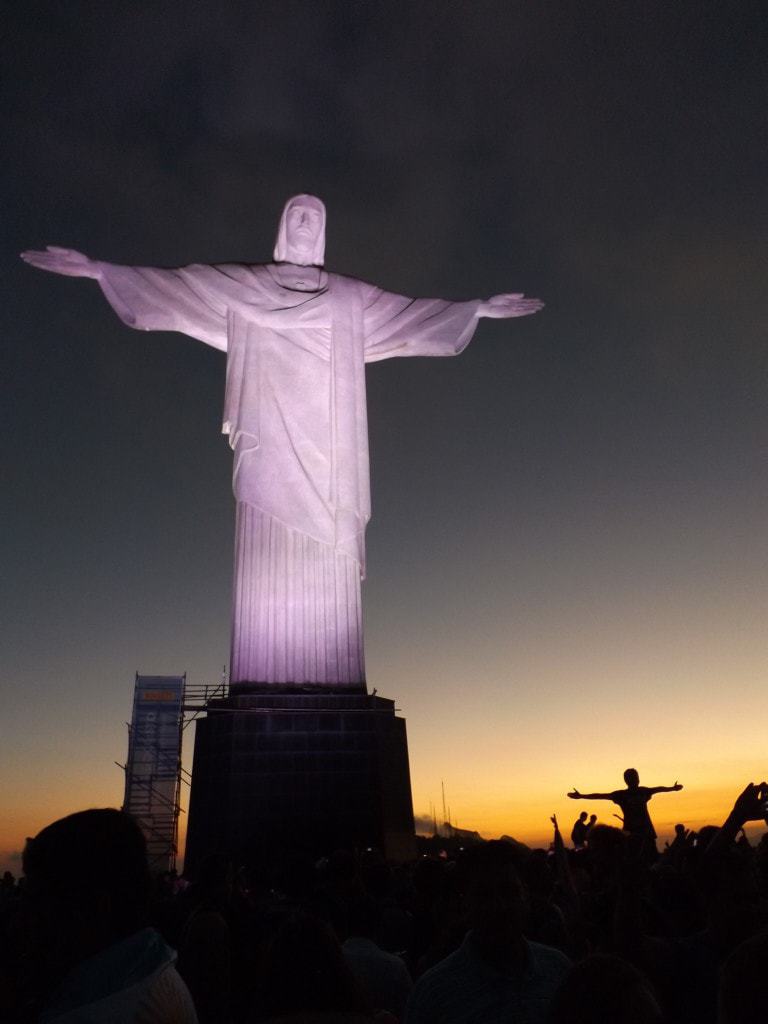
Disappointments aside, a couple of things redeemed our experience (pun shamelessly intended, I’m afraid). The site of Christ glowing white against an electric blue sky still lined with a vibrant, fading orange, is something I’ll remember forever.
The triumph, though, was the view of Rio. From our towering vantage point, we could make out a shimmering, watery blanket of tiny lights. Twinkling apartment buildings surrounding that enormous lake in the middle of the city. Minuscule cars crawling up and down neat little roads between street lights. It was an arresting sight, all that light and motion squashed up against the inky darkness of the Atlantic Ocean: the chaos and noise of Rio reduced into a miniature, pulsing lightscape.
Even though we missed the sunset, and had to battle a rib-crushing crowd for the right to look at a sight we had paid to see, and even though we had to queue for almost two hours in the cold to get back down the mountain… I’d say it was all worth it.
Christ the Redeemer is iconic for a reason, and there’s a reason it’s one of the best things to do in Rio de Janeiro. It was one of my absolute highlights of what was – for me – an unexpectedly wonderful city. A perfect ending to our time in Brazil, and to our five-month trip in South America.
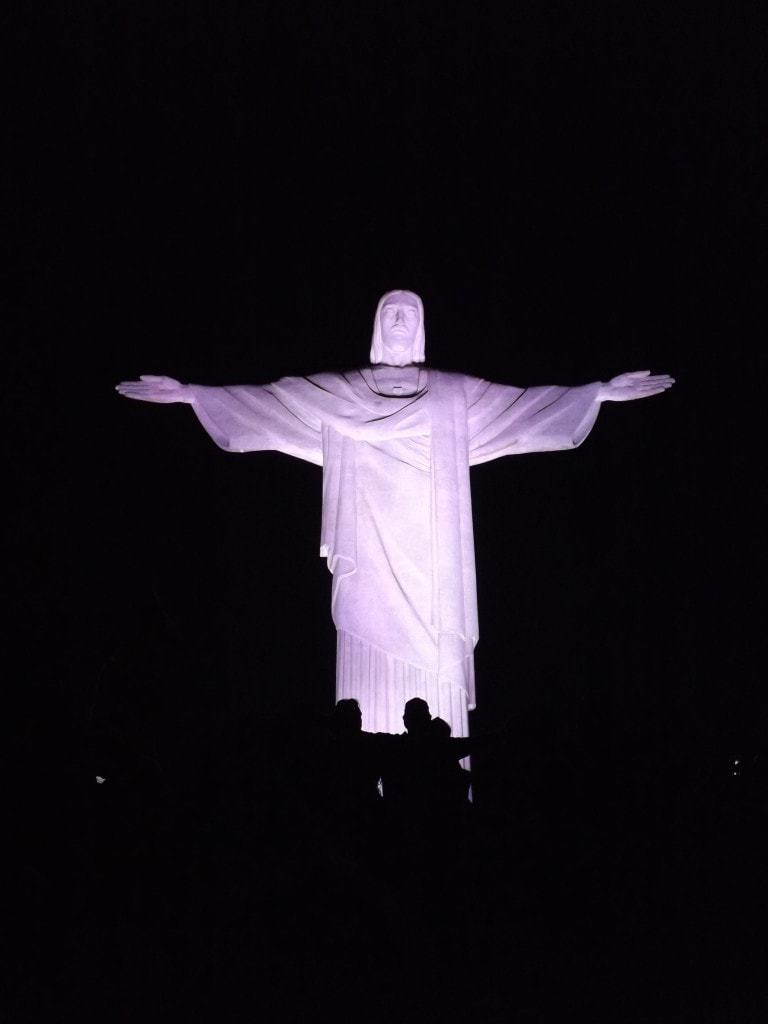
Read More
Read more about my South American Adventure in this timeline post.
Brazil was country number six on my backpacking trip in South America. Read about the other places I visited in my Colombia Diaries, my Peru Diaries, my Bolivia Diaries, and my Argentina Diaries.


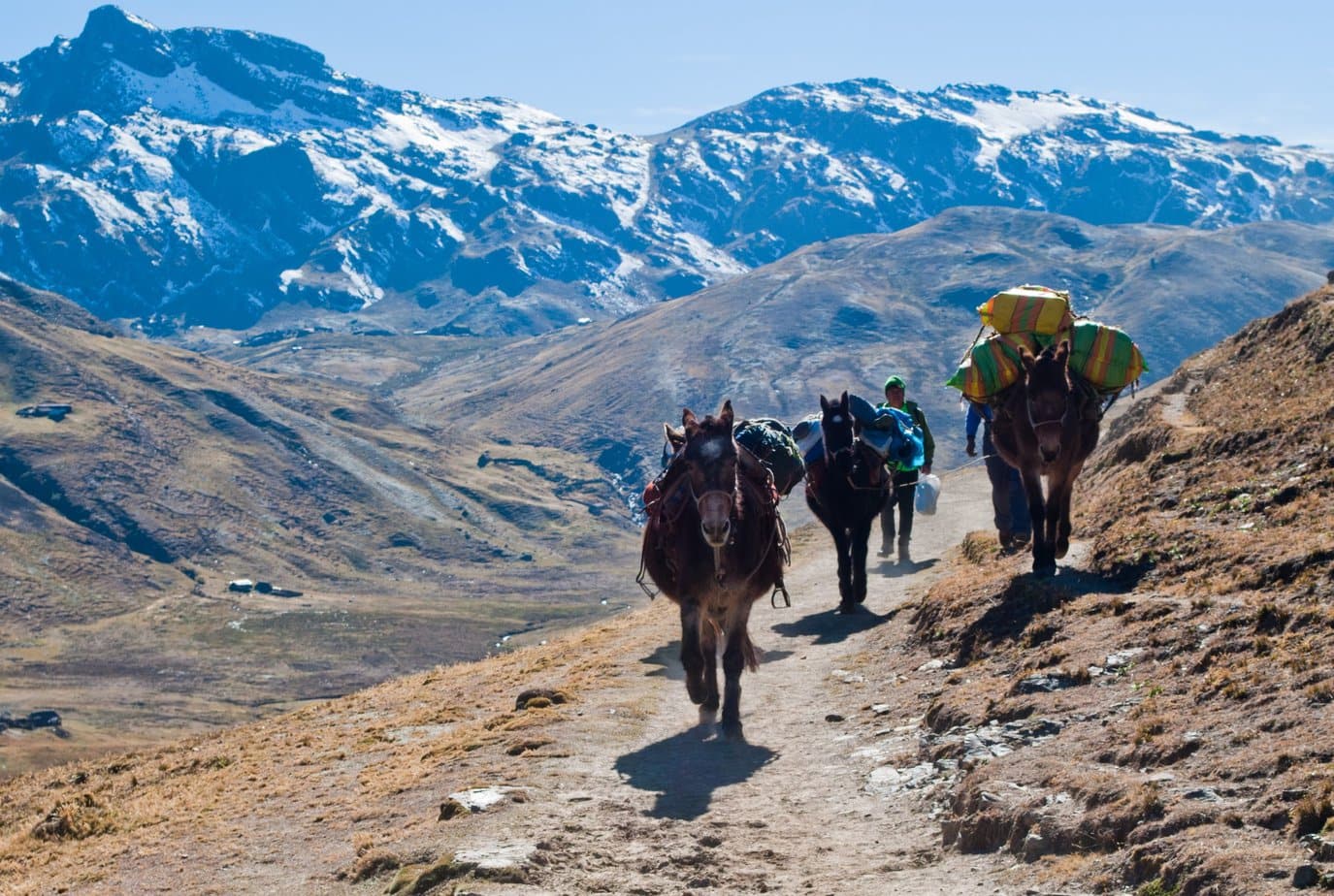

“I really did find myself disappointed when I saw people clicking their cameras a few times and then hurrying on to the next viewpoint of the trail.” Argh I know what you mean. And now I’m curious to visit after the description. Very interesting how things quickly change from one country to another.
It really is worth visiting – one of the absolute highlights of my whole South America trip!
Natures greatest accomplishments :)
Definitely!
Interesting to read about the comparisons between the 2 countries, cant wait to see for myself one day.
Thank you! Both sides actually offer pretty different experiences of the falls, which was unexpected :)
Staggeringly impressive is a good way to describe Iguassu Falls. I especially like your photo with the rainbow.
Thank you! There were so many rainbows in the spray, at one point we actually walked through a completely circular one!
I will definitely bring some quick-drying clothes for the Brazil side of Iguazu! A picnic lunch alongside the river sounds perfect after getting soaked by the falls. Definitely need to make it here before too long!
You should – it’s such an incredible place! One of the highlights of South America for sure (although there are many!) Do you think you’ll visit anytime soon?
you know they are serious falls when you can get multiple posts out of them and see them from different countries!
Haha I know – a waterfall spanning two countries is always going to be impressive! And such different experiences on both sides!
You did a great job of describing the falls. I was there on both sides and on the river, and that heavy mist feels SO good in the tropical heat! Definitely one of the most spectacular sights I’ve seen in my time.
Thank you – it’s so hard to describe something that really impressed you, because it feels like nothing will do it justice but the sight itself! Could you pick a favourite side? Because I really couldn’t!
I couldn’t decide, but I would say that being in a boat below the falls was definitely my favorite.
Ah I’m jealous, I didn’t get to do that!
Great article, Emily. After comparing your two articles I must admit you are right. Argentina´s side and the Brazilian side are different. Hope I can see the falls someday.
They really are incredible, don’t miss them if you ever go to South America!
I only saw it from the Argentinian side and was impressed with how close you could get. Best falls I have ever seen. Wonder what they are like from the Paraguay side?
I don’t think you can actually see them from Paraguay. There only seemed to be two sides, Brazil has one bank and Argentina has the other. But both sides are amazing!
Iguazu is definitely on my must visit list, I’m glad you took the time to go to both sides.
Me too – it was definitely worth while! Hope you get to visit soon!
Totally agree with you that when you experience a beauty like this, no matter how hard you try, you will never like the photos. But still you have done impressive work to show us, who haven’t still visited the place, what it looks like.
I’m glad you liked them! I don’t think any shot I’ve seen is as good as the real thing, but they’ll do u til you can see them for real :)
Totally agree with you that when you experience a beauty like this, no matter how hard you try, you will never like the photos. But still you have done impressive work to show us, who haven’t still visited the place, what it looks like.
Almost everyone I have spoken to that has visited said its a must to see it from both sides. I hope to do it one day….soon I hope…
I agree with them! If you can only visit one side, it’s still an incredible experience – but it really is worth it to see both!